Signals

September October November 2010 Number 92
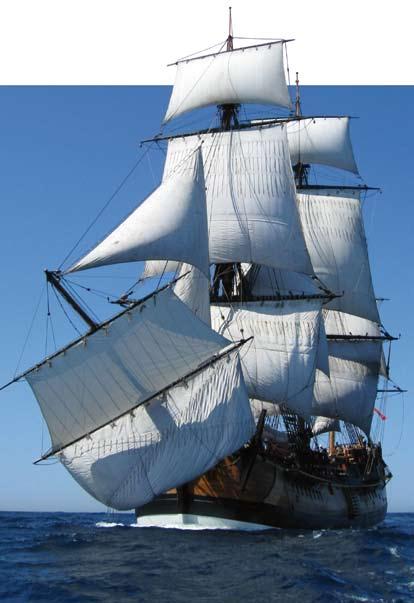
From April 2011 to May 2012 the magnificent replica of James Cook’s HM Bark Endeavour will follow in the wake of our earliest European explorers, visiting major and regional ports right around Australia.
Applications are now open for voyage crew and supernumerary berths – numbers are strictly limited – book your place now!
Bookings & information
Telephone 02 9298 3859 Freecall 1800 720 577 www.endeavourvoyages.com.au
Sail
as HMB Endeavour makes its first-ever circumnavigation of Australia.
with us
AUSTRALIA
Sydney
Adelaide
Portland Eden Voyages_Signals_A4.indd 1 5/8/10 12:44:43 PM
Broome
Darwin Cairns Townsville Gladstone Brisbane Melbourne
Hobart
Geraldton Thursday Island Exmouth Fremantle Bunbury Albany Port Lincoln
Four-year-old Stewart Lee, pictured on SS Strathnaver in 1955, was one of nearly 110,000 British child migrants sent to Canada, Australia, Southern Rhodesia and New Zealand alone, without their mothers or fathers, under a number of schemes that operated until the 1960s. A new exhibition On their own – Britain’s child migrants was developed as a collaboration between the Australian National Maritime Museum and National Museums Liverpool, UK, supported by the Australian Government’s National Collecting Institutions Touring and Outreach Program. Photograph reproduced courtesy of Sydney Lee.
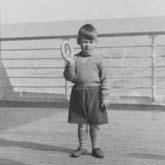
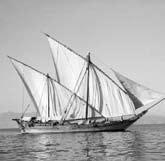
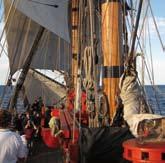
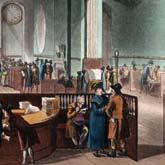
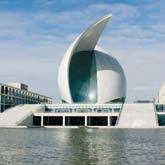
2 On their own – Britain’s child migrants
A travelling exhibition and collaboration between this museum and National Museums Liverpool, UK
14 Sailing with the sons of Sindbad
Alan Villiers, Australian writer and photographer recording vanishing traditions of sail, created a classic with his book on Arabian seafaring
22 Endeavour replica to circumnavigate Australia
An historic voyage around Australia in 2011–12 has been announced; learn how you can join in
27 Members events
From the Members manager … the spring calendar of talks, tours, cruises, seminars, activities afloat
32 What’s on Spring exhibitions and attractions for visitors young and old, school-term and vacation programs
36 Lots of Lloyd’s
What do Lloyd’s List and Lloyd’s Register offer researchers, 250 years after the register’s foundation?
42 China Maritime Museum opens in Shanghai Report on China’s ambitious new maritime attraction
44 USA Gallery revisited
Why did the USA fund a gallery in the national museum of another country?
50 Australian Register of Historic Vessels New additions to this important national database
52 Tales from the Welcome Wall
Separated for years by World War II, a family reunites in Melbourne
54 Collections
Reginald Fizelle’s Sydney Transport Montage
56 Readings Pirate outrages on the China Seas
57 Currents Plastiki; Kurnell artists; historic circumnavigator
60 Bearings From the director
Number
Signals September to November 2010
92 Contents
2 36 22 42
Cert no SGS-COC-006189
14

On their own Britain’s child migrants
S IGNALS 92 Se PT e MB e R TO N OV e MB e R 2010 2
A long ocean voyage carried generations of child migrants from the familiar to the unknown, to mixed fortunes and, too often, to suffering and sorrow. Curator of postFederation immigration, Kim Tao, relates their story, told in a new exhibition that’s a collaboration between the Australian National Maritime Museum and National Museums Liverpool, UK. It opens here on 10 November and will travel for three years to Australian and UK venues.
Dressed in oversized shorts and clutching a deck quoit, Stewart Lee cuts a forlorn figure at the entrance to our new exhibition On their own – Britain’s child migrants. Four-year-old Stewart was one of nearly 110,000 British child migrants sent to Canada, Australia, Southern Rhodesia and New Zealand alone, without their mothers or fathers, from the late 19th century to the 1960s.
These children travelled through government-sponsored schemes that removed them from their homes and families, or from workhouses and orphanages. It was believed that they would have a better life working in the clean expanses of the British Empire, where they were a source of much-needed labour. Instead, many were left to endure years of abuse, decades of loneliness and, in far too many cases, a lifetime of regret.
The children were organised for departure by many different charitable and religious organisations including Dr Barnardo’s Homes, the Fairbridge Society, the Church of England Waifs and Strays Society and the Christian Brothers. At the same time voluntary youth migration schemes were operated by the Salvation Army, Dreadnought Trust and Big Brother Movement, which shared similar aims to the child migration schemes. Youth migrants, however, being older than 16, usually had more control over their lives.
Child migrants were often labelled as ‘orphans’ even though many simply had parents who were unable to look after them. They were placed in temporary care and later emigrated without their parents’ consent.
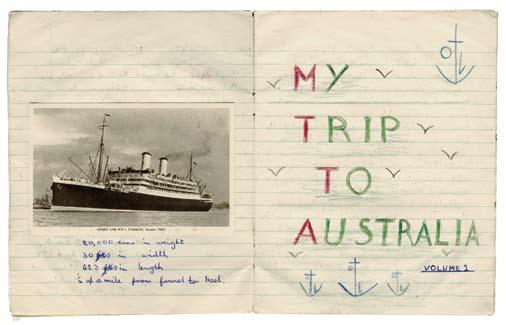
 left: Stewart Lee on SS Strathnaver 1955. Reproduced courtesy Sydney Lee
left: Stewart Lee on SS Strathnaver 1955. Reproduced courtesy Sydney Lee
S IGNALS 92 S e PT e MB e R TO NOV e MB e R 2010 3
right: Diary of Maureen Mullins’ journey from Britain to Fairbridge Farm School at Molong, near Orange, NSW, in 1952. Lent by Maureen Murray
Some families, such as Stewart’s parents, sought opportunities for their children through these schemes. In 1955 Stewart and his older brothers Sydney, Graham and Ian were sent from Manchester to the Fairbridge Farm School at Molong, near Orange, New South Wales. They were promised a good education and that they could return home in two years if they weren’t happy. This was not to be. They had been deported for life.
Britain has a sustained history of child migration dating back to 1618, when King James I authorised the transportation of 100 vagrant street children from London to the newlyfounded colony of Virginia, where ‘they may be sett to worke … otherwise [they] will never be reclaimed from the idle life of vagabonds’. This notion of reclamation, coupled with the insatiable demand for new settlers to exploit the colonies and consolidate the expanding British empire, would inform child migration policy for the next 350 years.
In the early 19th century Britain experienced rapid social change, resulting in a surplus of destitute and homeless children in growing cities like London, Liverpool and Glasgow. Organisations such as the Children’s Friend Society and Ragged Schools Union began sending these children to new opportunities in Canada and Australia. However, numbers remained relatively small until the 1860s, when a new breed of philanthropists led by Maria Rye, Annie Macpherson, Thomas Barnardo and William Quarrier sought to remove deprived children from the perceived evils of city life to the healthier environments of the British Dominions.
By articulating the economic benefits – it cost £12 per year to maintain a child in an institution but only £15 to send them to the colonies – they promoted mass child migration as a solution to the deprivation, neglect and homelessness that was endemic in Victorian Britain.
The voyage for many was a time of trepidation but also of excitement and adventure; new friends, new sights, new places
Dr Barnardo became one of the most influential figures in child migration, transporting more than 20,000 children to Canada. Sixteen-year-old Samuel Relf migrated to Ontario in 1894 with the second party from Barnardo’s London home at Stepney Causeway. He was taken to a distributing home in Toronto and then placed on a farm, and was eventually awarded a Barnardo’s good conduct medallion for commitment and loyal service to his employer. Samuel’s silver medallion is displayed in the exhibition, along with a selection of publications including Two Rescues! and Something Attempted, Something Done, which promoted the work of Barnardo’s and invited public donations to support further Canadian emigration.
Canada would receive 100,000 British child migrants, or ‘home children’ as they came to be known, many from the Liverpool Sheltering Homes.
Fourteen-year-old Frank Bray was sent to Canada by the Sheltering Homes in 1906, having spent several years in the South Stoneham workhouse in Southampton after his father died.
The workhouse, an institution where destitute people lived and worked to earn their keep, was the main form of poor relief during the Victorian era. Frank was posted to a farm in North Clarendon, Quebec, and wrote to his brothers and sister in Southampton to say, ‘I was sorry I came at first, but it soon passed off and now I am as happy as a lark.’ Frank became one of the child migration scheme’s success stories; his master Mr Hodgins bought him a farm of his own to run when he turned 18.
Not all child migrants were as fortunate as Frank. One of the emigrant register books in the exhibition, from Annie Macpherson’s Home of Industry in Spitalfields, London, documents the tragic case of 13-year-old Edith Jennings, who was sent to Canada in 1910. Her records show she attempted to take her own life at each of the three situations in which she was placed.
The visual record of these child migration schemes is dominated by promotional photographs of cheering children departing the UK.
top: First party to Fairbridge Farm School, Molong NSW, in 1938. Reproduced courtesy Molong Historical Society
bottom: The fourth party of children depart Britain for Fairbridge Farm School, Molong NSW, in 1939. Reproduced courtesy Molong Historical Society
In 1925 shifting attitudes to child migration saw Canada introduce a temporary ban on children under 14 entering the country. This ban was made permanent in 1928 and Australia then became the main destination for Britain’s child migrants.
The shift to Australia was spearheaded by the Fairbridge Society and Dr Barnardo’s Homes, which sought ‘good British stock’ to populate, settle and ultimately maintain a white Australia. The Australian government actively pursued the continuation of the schemes in its postwar ‘populate or perish’ immigration policy, receiving more than 7,000 child migrants until 1967, when the last official party arrived by air with Barnardo’s.
Until the early 1960s most child migrants travelled by sea. Before leaving, children underwent intelligence tests, medical examinations and clothes fittings, and were feted with tea parties, mayoral receptions and even visits by royalty. The migration organisations ensured maximum publicity for the departure to promote their work.
Children were brought from across the UK to board ships at ports such as Liverpool, Glasgow, Southampton and London. The voyage for many was a time of trepidation but also of excitement and adventure; new friends were made, new sights seen, new places found to explore and play in. Twelve-year-old Maureen Mullins recorded all the sights and delights of her 1952 voyage on SS Otranto in her diary – the ‘gigantic’ Rock of Gibraltar, a funicular ride and ‘real Italian spaghetti’ in Naples, bathing in the Mediterranean Sea, and sampling sugar bananas and coconuts in Colombo. The diary is a highlight of the exhibition and also epitomises the highpoint of the child migrant’s journey.
Upon arrival children were confronted with harsh realities. Separated from siblings and friends, they were taken long distances to isolated and strange environments, whether in private farms
S IGNALS 92 Se PT e MB e R TO N OV e MB e R 2010 4
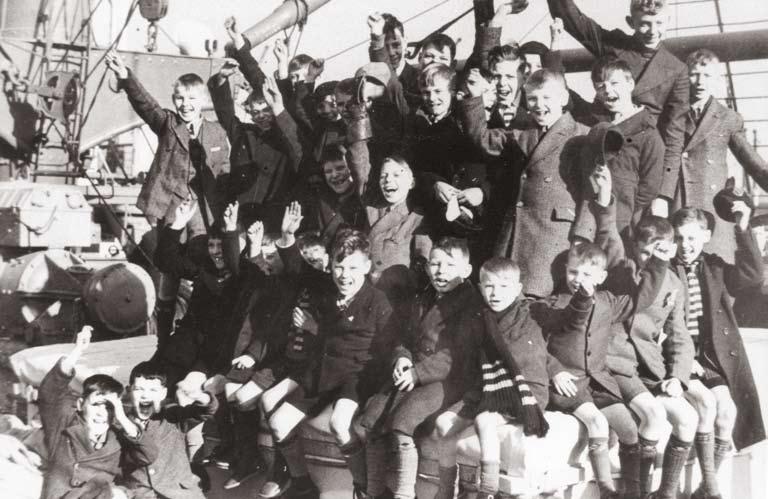

S IGNALS 92 S e PT e MB e R TO NOV e MB e R 2010 5
left top to bottom: Child migrants picking peas at Fairbridge Farm School, Molong NSW, in 1949. Reproduced courtesy National Archives of Australia: A1200, L11583
British immigrant children from Dr Barnardo’s Homes at landing stage, Saint John, New Brunswick 1920s. Reproduced courtesy Isaac erb/Library and Archives Canada/PA-041785
Boys burning off at Fairbridge Farm School, Pinjarra WA. Reproduced courtesy State Library of Western Australia, The Battye Library 4648B/5
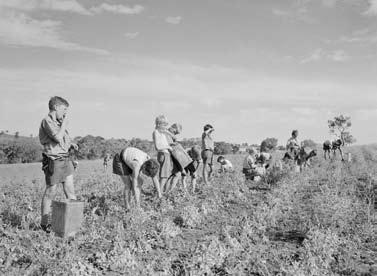
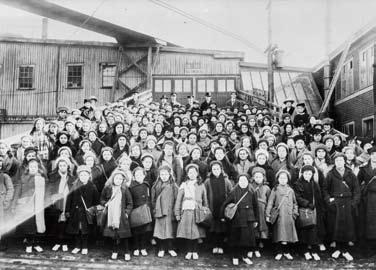
below top and centre: Young migrants were put to work as construction labourers to build this block at Christian Brothers’ Bindoon Boys’ Town, WA, 1952. Reproduced courtesy State Library of Western Australia, The Battye Library 004025D, 004026D
right: Scythe, mattock and sickle used by child migrants at Fairbridge Farm School, Molong NSW. ANMM collection, gift from Peter Bennett. Photographer A Frolows/ANMM
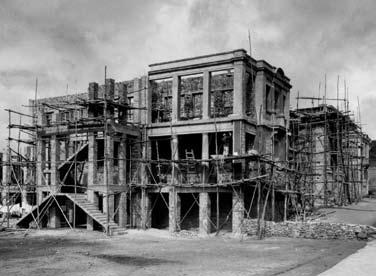


S IGNALS 92 Se PT e MB e R TO N OV e MB e R 2010 6

across Canada or institutions in Australia. They faced long hard days of labour in extremes of climate without the love of a family. The expectations were that boys would become farmers and girls would be domestic servants or wives on the land. Most received limited education and were set up badly for adult life.
Stewart Lee and his brothers were separated on arrival at Fairbridge Farm School in Molong, their new clothes and shoes removed and replaced with khaki work clothes and bare feet. Molong was one of three Australian farm training schools established under the principles of Kingsley Fairbridge, a South Africanborn Rhodes scholar who sought to alleviate the plight of disadvantaged British children by sending them to farm schools in the colonies. With the assistance of the Western Australian government his first school was founded at Pinjarra, south of Perth, in 1912.
Fairbridge Farm Schools were virtually self-sufficient with a dairy, bakery, vegetable garden, poultry, sheep and cattle. Children lived in small cottages, attended school until the age of 14 and then spent 12 to 18 months training in farm work on the property. Stewart’s brother Ian did not see a future in farm work and ran away from Fairbridge in 1963.
Twelve-year-old David Summerfield, on the other hand, jumped at the chance to undertake agricultural training in Australia. David had been placed in a Barnardo’s Home in Sussex after his mother died of tuberculosis. In 1950 he set sail on SS Maloja, bound for the Barnardo’s Mowbray Park farm school in Picton, south of Sydney. David says, ‘I was happy at Picton. I loved the sunshine and farm work. I thank Barnardo’s for sending me to Australia, away from the wet and cold of England’.
David kept in touch with Barnardo’s after leaving Mowbray Park in 1953. One of his letters from Barnardo’s,
displayed in the exhibition, hints at changes in child welfare practice following the sale of Picton, and the trend towards ‘smaller homes with not more than a dozen children … to take away that feeling of belonging to an institution’.
The dangers of institutionalisation became evident after World War II, when the Child Welfare Act 1948 was passed in the UK and child migration schemes came under scrutiny. Two investigations were carried out by British government officials – John Moss in 1952 and a Home Office team led by John Ross in 1956. While Moss was supportive of child migration as a welfare strategy, the Ross Committee was highly critical of the notion of institutional care. The committee’s report singled out five institutions for special condemnation, including the notorious Bindoon Boys’ Town north of Perth, which it concluded had ‘the disadvantage of isolation, unsuitable and comfortless accommodation, and a Principal with no understanding of children and no appreciation of their needs as developing individuals’.
Raymond Brand spent his childhood renovating buildings in primitive, unsafe conditions at Bindoon, one of four institutions operated by the Christian Brothers in Western Australia to keep up with the Protestant Fairbridge scheme. Raymond’s mother had signed him over for adoption in England, but instead the five-year-old was sent to Australia in 1953. His migration consent form, signed by the administrator of Father Hudson’s Homes in Birmingham, notes he was ‘suitable for migration’ with ‘average build, no visible defects, intelligence reaction favourable’.
Raymond was initially placed in the St Vincent’s home in the Perth suburb of Wembley, before being moved to Castledare junior orphanage, where he was repeatedly physically and sexually abused by his carers. He was later transferred to Bindoon and subjected
Many were left to endure years of abuse, decades of loneliness and, in far too many cases, a lifetime of regret
to further brutality and humiliating verbal abuse. Raymond left Bindoon educated only to Year Five and bearing mental scars which remain to this day.
Few British sending organisations were conscious of the long-term effects of separating children from their families, and the subsequent damage caused by loss of homeland and identity. As an adult, Yvonne Radzevicius spent two years in psychiatric care after discovering she had been lied to when told she was an orphan. Ten-year-old Yvonne was sent from Nazareth House in Glasgow to Geraldton, Western Australia in 1953 and remembers the nuns saying ‘my parents were dead and I had no brothers or sisters’.
In 1974 Yvonne was astonished to receive a letter from her godmother, informing her that her parents were alive and that she had five siblings. She returned to Nazareth House in Glasgow to find out more about her early life and was handed a tiny piece of paper with brief details of her name, mother’s name and date of birth. This precious piece of paper is on display in the exhibition. Yvonne was also shocked to learn that her mother had lived less than a mile from where she spent her childhood. Yvonne’s mother died two weeks after they were reunited in 1980.
Like Yvonne, Pamela Smedley grew up unaware of her family connections and was told, ‘Your mother had you in the hospital, walked out of the hospital and left you.’ In 1949 the 11-year-old was sent from Middlesbrough to the Sisters of Mercy’s Goodwood Orphanage in Adelaide.
Pamela left the harsh conditions of Goodwood at 15 and went into domestic service at an isolated shearing station five hours from Adelaide. Although she needed clothing and other items Pamela spent her entire first pay on a miniature English house to remind her of England. The cherished little house – which Pamela
S IGNALS 92 S e PT e MB e R TO NOV e MB e R 2010 7
It cost £12 per year to maintain a child in an institution but only £15 to send them to the colonies

S IGNALS 92 Se PT e MB e R TO N OV e MB e R 2010 8
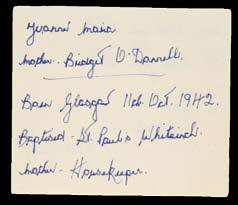
above: This was the only information Yvonne Radzevicius could get from the nuns at Nazareth House, Glasgow, when she was trying to locate her birth mother. Lent by Yvonne Radzevicius
above right: Miniature english house bought by Pamela Smedley with her first wage, to remind her of where she came from. The photograph (right) shows her reunited with her mother Betty. Lent by Pamela Smedley
left: Passenger list for a voyage on the P&O liner Strathaird in 1938, carrying Catholic boys aged seven to 13 to Western Australia. Reproduced courtesy The National Archives, London
below: Child migrant memorial, Fremantle 2006. Reproduced courtesy Department of the environment, Water, Heritage and the Arts
below right: The Salvation Army chartered the White Star liner Vedic to bring youth migrants to Australia in the 1920s. Reproduced courtesy Salvation Army
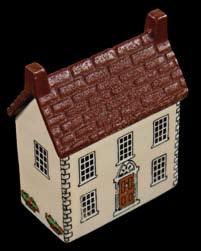



S IGNALS 92 S e PT e MB e R TO NOV e MB e R 2010 9
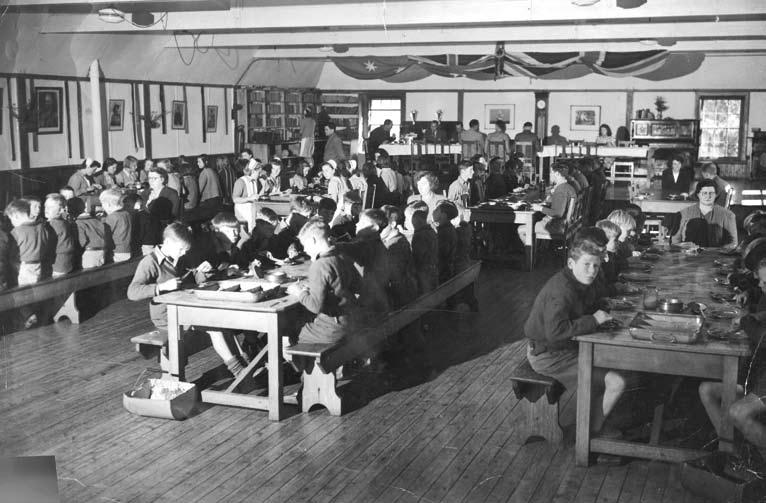
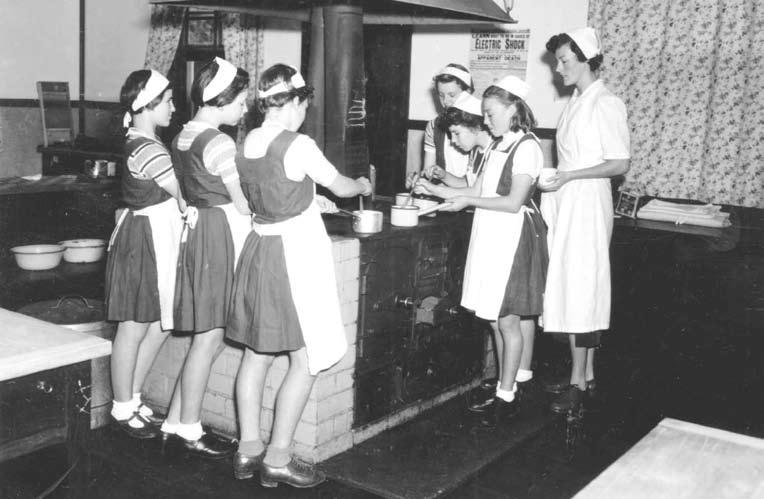
S IGNALS 92 Se PT e MB e R TO N OV e MB e R 2010 10
top: Nuffield Hall dining room at Fairbridge Farm School, Molong NSW, in 1948. Reproduced courtesy Molong Historical Society bottom: Girls at a cookery lesson at Fairbridge Farm School, Pinjarra WA, 1953. Reproduced courtesy State Library of Western Australia, The Battye Library 010791D
has kindly lent for the exhibition – is highly evocative, symbolising a young girl’s longing for family, home and somewhere to belong.
In 1989 Pamela contacted the Child Migrants Trust, founded by Nottingham social worker Margaret Humphreys to reconnect former child migrants with their families. With the help of the Trust Pamela was reunited with her mother Betty. For 40 years Betty had believed Pamela was adopted by a loving family in England.
The general public had little awareness of child migration until the schemes were exposed by the Child Migrants Trust and two television documentaries, Lost Children of the Empire and The Leaving of Liverpool, more than 20 years after the last child migrants arrived in Australia.
The child migration schemes were no longer viable because of shifting social attitudes, changes to child welfare practice in the UK and Australia and the subsequent dwindling supply of children. With the end of the schemes the institutions began to close from the 1970s. Today many former child migrant institutions have been adapted for educational and family use. The Christian Brothers operate Bindoon as a Catholic agricultural college, while Fairbridge Pinjarra and Mowbray Park offer farm holiday accommodation. Some Canadian distributing homes are used as private residences but Fairbridge Molong lies derelict – a fitting metaphor for the end of Britain’s child migration schemes.
For former child migrants the legacy of their experience remains. Many have struggled, not only due to the hardships and abuse they endured, but also because of the damage caused by removal from their homeland. Others were lucky enough to find fulfilment in their lives. Regardless of their experiences, many former child migrants and their descendants value their history and work hard to preserve it.
Fairbridge Molong lies derelict – a fitting metaphor for the end of Britain’s child migration schemes
were wrong, express regret for the psychological, social and economic harm caused to children, and provide funding for memorials to commemorate former child migrants. Memorials have since been erected throughout Australia, taking the form of sculptures in Adelaide, Fremantle and Sydney, and an s-shaped love seat in Melbourne that alludes to the plight of former child migrants caught between two countries.
In 1991 Canadian teacher David Lorente, son of a British home child, established Home Children Canada to help former child migrants locate their records and families. The International Association of Former Child Migrants and Their Families was launched in 1997 to represent the needs of child migrants and their families. In the late 1990s association members actively campaigned for an Australian judicial inquiry into all aspects of child migration policy, following the British Health Select Committee’s 1998 inquiry The Welfare of Former British Child Migrants, which described child migration as ‘a bad and, in human terms, costly mistake’.
In 2000 the Australian Senate, on the motion of former Rhodesian child migrant Senator Andrew Murray, referred the issue of child migration to the Community Affairs References Committee. Two inquiries were held: Lost Innocents: Righting the Record – Report on Child Migration (2001) and Forgotten Australians: A Report on Australians Who Experienced Institutional or Out-of-home Care as Children (2004).
Lost Innocents concluded that child migration schemes were ‘fundamentally flawed with tragic consequences’, and recommended that the Commonwealth and state governments issue a formal statement to acknowledge the schemes
Years of lobbying finally came to a head in November 2009 when Australian Prime Minister Kevin Rudd delivered an emotional apology to half a million ‘Forgotten Australians’ and former child migrants who suffered in institutional care during the 20th century. Mr Rudd acknowledged the particular pain of child migrants who were ‘robbed of your families, robbed of your homeland, regarded not as innocent children, but regarded instead as a source of child labour’.
The Canadian government has designated 2010 as the Year of the British Home Child to recognise the tremendous contribution of former child migrants –and their estimated four million descendants – to the building of Canada.
In February 2010 British Prime Minister Gordon Brown apologised on behalf of the nation to innocent and vulnerable former child migrants who suffered hardship under ‘misguided’ schemes. Mr Brown acknowledged ‘the human cost associated with this shameful episode of history’ and announced a £6 million restoration fund to support travel and other reunion costs, echoing an earlier support scheme established by the UK Health Department to pay for family reunions.
For Stewart Lee, it was 40 years before he returned to the UK and reunited with his five siblings, including a sister he never knew about. ‘I love England,’ Stewart says. ‘We got to Manchester and I was home again.’
S IGNALS 92 S e PT e MB e R TO NOV e MB e R 2010 11
e xhibition opens at the Australian National Maritime Museum on 10 November and will travel for three years in Australia and the UK
On their own – Britain’s child migrants, a collaboration between the Australian National Maritime Museum and National Museums Liverpool, UK, is supported by the National Collecting Institutions Touring and Outreach Program, an Australian Government program aiming to improve access to the national collections for all Australians. Visit the exhibition website www.britainschildmigrants.com.

The exhibition
One of the challenges in developing an exhibition about child migration was the lack of objects associated with the subject. Museums use objects to communicate stories, but invariably former child migrants told us they had very few personal belongings when they left the UK. As one former child migrant noted: ‘everything you owned which was personal, they took away from you … you had nothing which was your own.’
Many child migrants remember the joy of receiving trunks or suitcases packed with an array of new clothes and shoes for their journey – and their utter dismay when these were removed on arrival and sent back to Britain for use by the next party.
The most common items we came across were documents, generally obtained later in life when Freedom of Information legislation allowed former child migrants to access their records and discover those details that form the very core of our identity – name, date of birth, place of birth and names of parents – details we usually take for granted.
However, the reliability of many records – and recordkeeping procedures – is questionable and makes it difficult to determine the precise number of child migrants sent from the UK. Numbers for Australia vary widely from 3,000 to 30,000, the latter figure probably taking into account voluntary youth migrants who arrived between 1911 and 1982. The 2001 Senate Inquiry Lost Innocents: Righting the Record established that some 7,000 child migrants were sent to Australia during the 20th century; approximately half pre-World War II and half postwar.
Some organisational records have been deposited in public collections; for instance the Fairbridge Society files are held at the University of Liverpool and the Fairbridge Pinjarra files at the State Library of Western Australia. Records relating to Rhodesia Fairbridge Memorial College, on the other hand, were destroyed after the school closed in 1962 by order of the London council.
Dr Barnardo’s Homes kept meticulous records of all the children in its care, as evidenced in detailed registers and an extensive photographic archive that includes individual portraits of children taken prior to their departure from the UK. Barnardo’s, and other organisations such as Fairbridge and the National Children’s Homes, also photographed parties of smiling happy children sent to Canada and Australia.
These photographs were taken to promote the work of sending organisations and some are now in the public domain.
The selection of photographs and records for On their own was guided by privacy and copyright laws, as well as ethical concerns voiced by involved organisations. Consequently the visual narrative of the exhibition is largely drawn from these public domain images, providing an insight into how proponents of the child migration schemes became expert publicists and fundraisers who attracted the patronage of British aristocracy and royalty.
The photographic record contrasts remarkably with the raft of written and oral testimony of former child migrants. It is without doubt a contested history. Many former child migrants are still coming to terms with their deportation and dislocation, and condemn the schemes for removing them from their family, country and culture. Others prospered and vigorously defend the charitable organisations, maintaining that the nature of work and discipline were acceptable by the standards of the time. Opinions vary, even among child migrants who were at the same institution at the same time.
There is no single narrative and many issues – exploitation, abuse, punishment, compensation – remain unresolved. We have taken the approach of presenting ‘case studies’ in the exhibition to showcase an individual perspective and juxtapose official history with lived experience. The case studies provide an opportunity to be heard and believed, for those who were neither heard nor believed when they were powerless children.
We developed the exhibition over several years and against a changing political landscape that culminated in two formal government apologies to former child migrants and their families. The exhibition development process raised fascinating questions about the construction – and deconstruction – of history and the complex historiography of Britain’s child migrants.
right: In the 1920s publications such as this one promoted the mutual – and overtly imperialist – benefits of youth migration and population growth. They were aimed at adolescents whereas the child migration schemes targeted children from three to 16 years old. Reproduced courtesy State Library of Victoria
S IGNALS 92 Se PT e MB e R TO N OV e MB e R 2010 12

S IGNALS 92 S e PT e MB e R TO NOV e MB e R 2010 13
Sailing with the sons of Sindbad
Alan Villiers the Australian Arabist
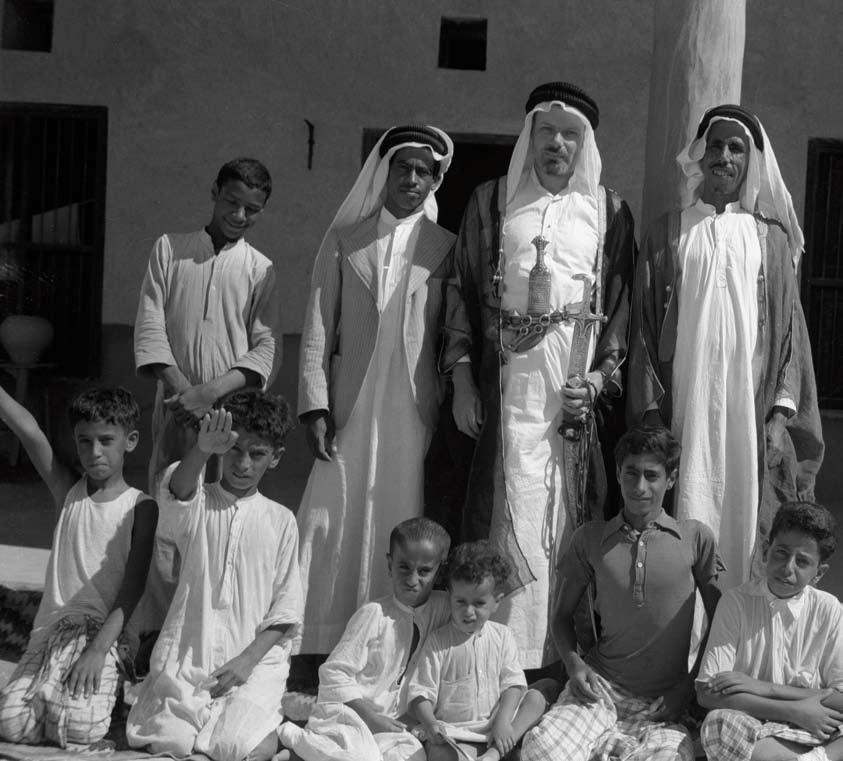
S IGNALS 92 Se PT e MB e R TO N OV e MB e R 2010 14
The exhibition Sons of Sindbad – the photographs of Alan Villiers in our South Gallery owes much to the research of Australian writer Grace Pundyk. She has helped to restore Villiers to his rightful place among the leading Western writers about the Arabian world, such as Gertrude Bell, T e Lawrence and Wilfred Thesiger.
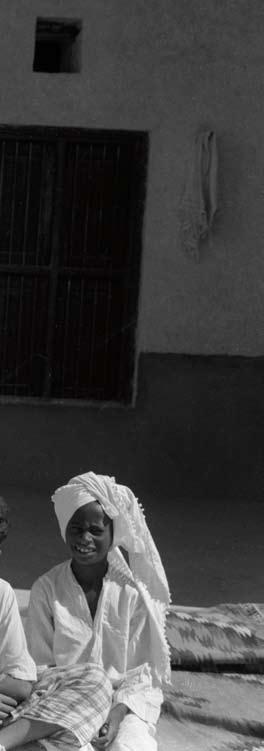
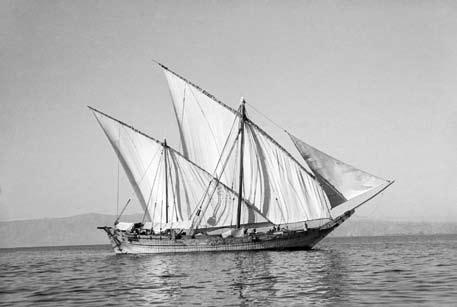
It was the caption of the photograph that initially caught my eye. I’d been doing my usual lunchtime rummage in the archives of the Kuwait Oil Company, where I was editor of its English-language quarterly, and had come across the book Kuwait by the First Photographers. It wasn’t that old, published two years previously in 1998, but the photos it contained captured a bygone era, a time before oil wealth brought rapid transformation to this tiny state. There were buildings made of coral, Bedouin families selling brushwood in the town square, old men fishing from tiny watercraft made of the spines of date palm fronds lashed together, waterskinladen donkeys trudging through the shallows, rows of dhows towering behind them. Every image fascinated me and I took a longer than usual lunch that day to study the book further.
The photographers were mostly the usual suspects – the British ‘travellers’ (read political agents, diplomats or spies) exercising some Imperial muscle in the guise of desert redemption. But it was the eye behind the lens of this one particular photo, of British political agent Major A C Galloway lounging with Kuwait’s Sheikh Ahmad bin Jabir Al-Sabah aboard the sheikh’s steam yacht,
that really stood out. The caption identified the photographer as an Australian by the name of Alan Villiers. It was dated 1939. And while the handsome sheikh and relaxed diplomat were certainly a telling portrait of the political alliances of the time, all I kept wondering was, ‘What was an Australian doing in Kuwait in the 1930s?’
Alan Villiers, born in Melbourne in 1903, made a name for himself as a maritime adventurer in the 1920s and 30s. His passion for sail and the sea led him to sail the world in the last of its fleet of tall ships. Shorebound after an accident on a Finnish barque, a job as a journalist on The Hobart Mercury allowed him to discover his great flair for writing and photography. He would publish a whole library of books and numerous articles on his travels and voyages, which would include a whaling voyage to the Antarctic and voyages as part-owner of a fourmasted steel barque, Parma, carrying grain from Australia to Britain. Selling her for a profit he bought his own threemasted ship, renamed her Joseph Conrad and during 1934–36 made an epic voyage around the globe. The circumnavigation’s route was inspired by the voyages of James Cook, but Villiers the writer drew as much inspiration from the ship’s Polish-British namesake.
above: A deep-sea boom under full sail off the southern Arabian coast, augmenting her lateen mizzen and settee mainsail with a jib flying from a demountable bowsprit.
All images lent by National Maritime Museum, Greenwich UK
Villiers’ decision to travel to Arabia in 1938 was borne of the certainty that he was living through the last days of sail. Having recorded the last of Europe’s tall ships, he wanted to document the sailing traditions of pre-industrial cultures before they too disappeared. The Arabian dhow and its voyages on the monsoon winds was his first choice from a long list
left: Alan Villiers with friends in Kuwait, 1939. ‘I’m the one with the cutlery,’ he wrote.
S IGNALS 92 S e PT e MB e R TO NOV e MB e R 2010 15
of journeys he’d identified for such a project. ‘There were still large fleets,’ he wrote in The Set of the Sails, ‘quietly going about their share of the world’s seaborne trade in the Indian Ocean and the waters of East Asia … and I proposed to make an exhaustive survey of the types of ship and the trades I came across, and to photograph and make films as records.’
This wider survey, however, was not to be. With a world war on the horizon Villiers managed just this one trip. Nevertheless, his choice was an important one as Villiers himself said:
‘It seemed to me that having looked far and wide over 20 years of a seafaring lifetime, that as pure sailing craft carrying on their unspoiled ways, only the Arab remained making his voyages as he always had, in a wind-driven vessel sailing without benefit of engines. Only the Arab still sailed his wind ships over the free sea, keeping steadfastly to the quieter ways of a kinder past.’
Of course, back in the year 2000, in that dusty archive in the middle of an oily desert, I knew none of this. In fact, when I came upon that first photograph, I’d never even heard of Alan Villiers. It seems shameful to admit this now, knowing what I do of this extraordinary man, and even more so that I, a fellow Australian, came only to learn of him through living in a distant country, one that has long remembered the man for the contribution he made to recording their own culture and history. But life is never linear. And all we can do is navigate its kaleidoscope of journeys, seemingly random but always interconnected, as they unfold in time.
Eventually I left Kuwait for Singapore to embark on a new life. Various other projects ensued but I just couldn’t let go of this Alan Villiers fellow. I had to know more. A trip back to Australia to read through his Arabian journals, held at the National Library of Australia, revealed that Villiers had travelled aboard a Kuwaiti-owned and crewed boom, or large trading dhow, called the Bayan, which Villiers freely translates as the Triumph of Righteousness. This journey commenced in the Yemeni port of Aden following a route that Arabia’s mariners had been making from time immemorial; around the Arabian peninsula and down the east coast of Africa, returning at the change of monsoon winds next season.
I also learned that he had written an account of his journey, Sons of Sindbad, published by Hodder & Stoughton, London, and Scribners, New York, in 1940. This turned out not only to
be a ripping sea-dog yarn but also a great classic of Arabian travel, a rich study of the ways of life, politics, governments, ancient and modern trade, people and cultures at the western edge of the old Indian Ocean world. It ranked, as far as I was concerned, with Wilfred Thesiger’s famous Arabian Sands, which it predates by a decade and a half. And it’s the only book of this genre – travelogue and ethnography – to have at its centre the seafaring Arabs. Yet amazingly the book had long been out of print and, it seemed to me, was in danger of falling into obscurity.
It was this realisation that propelled what became my campaign to restore Alan Villiers to the recognition he deserved in the field of Arabian studies. I packed up my belongings in Singapore and moved to the UK where I took up a scholarship to do a Masters in Arab Gulf Studies at Exeter University’s Institute of Arab and Islamic Studies. The focus for my thesis was, of course, Villiers and his Arab dhow voyages, but I also wanted to find a way of getting Sons of Sindbad republished.
The vogue for republishing Arabian travel narratives had so far been confined to the better-known travel writers. This celebrity cast of overland explorers who have dominated the story of the West’s discovery of Arabia and its peoples included those writers, travellers, archaeologists, and influencers of British Imperial policy Gertrude Bell (Arabian Diaries 1913–14) and T E Lawrence (Seven Pillars of Wisdom). There was the naturalist, political officer and adviser of Saudi royalty Harry St John Philby (The heart of Arabia) and one of the few women to travel through the Arabian deserts, Freya Stark (The Southern gates of Arabia). Wilfred Thesiger crossed Arabia’s Empty Quarter in the late 1940s, extolling his love for the desert’s space, silence and cleanness in Arabian Sands All were intimately linked with British political power in the Middle East.
Yet as far as I was concerned Villiers, too, deserved to be included in this A-list. Why, then, had he not been recognised?
It seemed to me that his focus on the sea was the main obstacle. For a start, it was not the purifying voyage of personal redemption across a barren desert, accompanied by noble asil (‘pure’) Bedouin escorts, that was commonly associated with Arabian travel narratives. Villiers’ sea journey followed a welltravelled, centuries-old route, entirely unexotic and unromantic in its everyday humdrum routine and at odds with the
Having recorded the last of Europe’s tall ships, Villiers wanted to document the sailing traditions of pre-industrial cultures before they too disappeared
top: Alan Villier’s genial host Captain Mansur (centre) and crew of zarook Sheikh Mansur, on which the Australian writer made his first Arabian voyage, from Aden to the Arabian port of Jizan on the Red Sea in 1938.
right: A two-masted trading dhow known as a baggala undergoing hull maintenance at Kwale Island off the coast of Tanganyika (Tanzania). It was one of the last of these deep-sea dhows, their lavish stern galleries believed to show the influence of early Portuguese explorers’ ships.
S IGNALS 92 Se PT e MB e R TO N OV e MB e R 2010 16
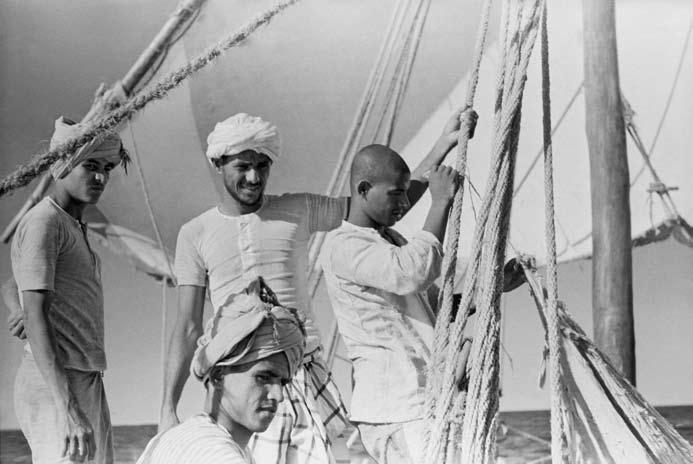
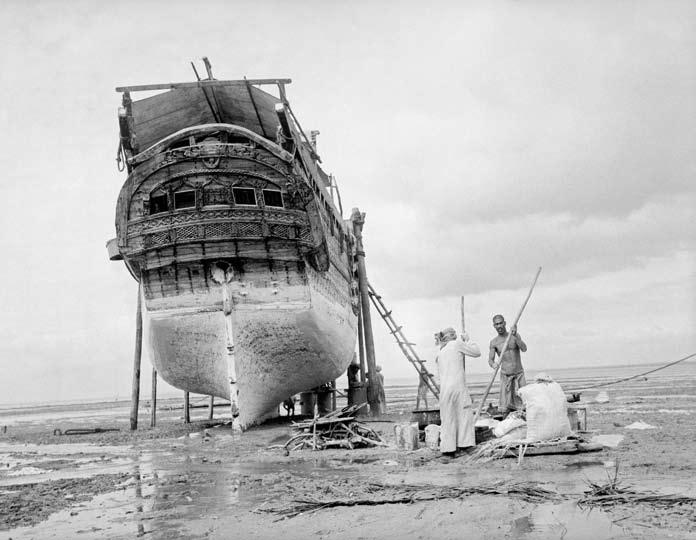
S IGNALS 92 S e PT e MB e R TO NOV e MB e R 2010 17

S IGNALS 92 Se PT e MB e R TO N OV e MB e R 2010 18
‘Only the Arab still sailed his wind ships over the free sea, keeping steadfastly to the quieter ways of a kinder past’
journeys taken by his desert counterparts. His description of Bedouin passengers undermines their fabled desert nobility. Aboard the Triumph of Righteousness they are simply poor and homeless refugees, fleeing famine and hardship and hopeful of starting afresh in distant lands.
Certainly, the sea has long played a vital role in the lifestyles, politics, economies, history and traditions of this diverse region. Yet for devotees of Arabian travel it has been regarded not so much as ‘other’, but as ‘nowhere’, that in-between, borderless space to be endured in order to get from A to B. Viewed this way, Villiers’ story is set literally off the map. By substituting the seas for the desert, it was as if he had automatically disqualified himself as an authentic Arabian traveller.
Not that he’d have cared. Villiers was as modest as they come, with an attitude so wholly lacking in superiority, with that Australian instinct for a ‘don’t imagine you are any better’ inclusiveness, that it is no wonder he was so respected by his fellow crew members and by passengers alike. Of course, his skill as a seaman was paramount in his ability to write this firsthand account of life aboard dhows, and to contribute to the workings of the ship. It also contributes to the way that Villiers, like Thesiger, travelled among his companions as an equal. At first critical of some of their methods, he soon came to appreciate their knowledge, which he conceded was often superior to his own. In fact, Villiers celebrates the dhow sailors’ extraordinary toughness and stamina and their ability to do without on unbelievably slender means.
But I also believe that in addition to his seamanship it was his Australianness that helped align him with the Arabs. His upbringing in a working class milieu, for example, is reflected in his native hostility to letter-of-the-law bureaucratic controls, which made him sympathetic to his Arab seafarers as they struggled with British officialdom in colonial ports. And his inclination to support the underdog, that particularly Australian tendency to make heroes of noble failures, shines through in his attitude to the sailors, one of whom he describes as ‘such a thorough scoundrel, so absolutely without pretence, so genuinely and wholly what we call bad that I rather admired him’.
In many ways Villiers mirrored Australia’s position at the time, an independent colony still tied to the Empire but not quite established in its own identity. Villiers, as an Australian, may have been loyal to Britain, but he also
hailed from a colonial frontier – just like the Arabs, who had seen Britain assert its power over them in the guise of ‘protection treaties’. Neither he nor the Arabs were colonisers; both were travellers. And, unlike his British writer counterparts, Villiers was an independent traveller with no political affiliation to empire. It is an interesting juxtaposition, therefore, that his journey was by sea.
The wide scope of Villiers’ interests, not only in sailing but also in the economics of the dhow and pearl trades, and the social conditions of those engaged in them, lifts the book out of the niche of sailing memoirs and certainly places it squarely within the larger genres of travel writing and ethnographic study. He was, in a real sense, the Wilfred Thesiger of the Arabian Sea, and such a claim is based not just on his writings but also, like Thesiger’s, on his photography – the subject of the Australian National Maritime Museum’s current exhibition.
Villiers, who died in 1982, bequeathed his entire photographic and film collection to the National Maritime Museum in Greenwich, UK. Photographs taken on voyages such as those on the majestic tall ships Grace Harwar, Herzogin Cecile and Parma had long attracted wide attention through his many successful books, not only for their subject matter but also for the spectacular beauty of their composition.
In the first edition of Sons of Sindbad, 50 photographs were published and as part of my research I decided to take a trip to Greenwich to view these images at first hand. What I found exceeded my expectations. For the small, dark room I was directed to contained not just 50 but hundreds of photographs, as well as negatives and contact sheets, from his Arabian journeys. Villiers himself had scrawled detailed captions on the back of many of them. Stored haphazardly in boxes and paper bags, the collection had clearly been forgotten, hiding in the shadow of Villiers’ more celebrated tallship photography.
I sifted through this treasure, of Kuwait’s dhow sailors, of the ports along the routes of his voyages, of Kuwait itself and its people, and of the pearl-divers of the Arabian Gulf. Here were images of a time now past, when the wealth that would ensue from the discovery of oil was still something unimaginable for this desert state. Kuwait had enjoyed no natural resources of its own, not even fresh water. Over the previous two centuries, however, its rulers and people had drawn on their strategic location and
S IGNALS 92 S e PT e MB e R TO NOV e MB e R 2010 19
Crew of Triumph of Righteousness climbing and working aloft on the massive main yard. This was the deep-sea trading boom that was home to Villiers for six months in 1938–39 during a voyage on the old Indian Ocean monsoon trading routes from Arabia to east Africa and back to Kuwait.
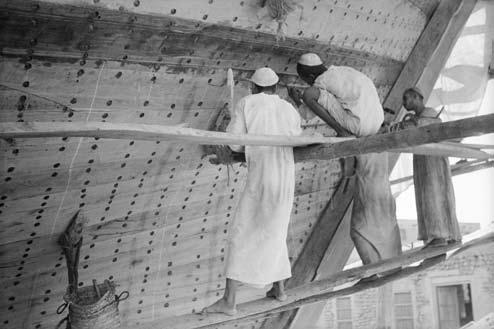
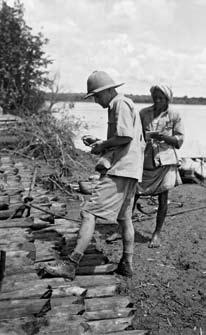

Women come to buy dates and other goods from the waterfront.
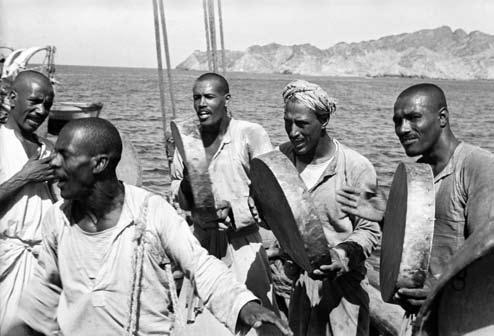 above: An official of the British colonial government of Tanganyika (Tanzania) checks the mangrove-pole cargo bound for treeless Kuwait.
right from top: Recaulking the hull planking with oakum made of shredded coconut fibre soaked in oil.
above: An official of the British colonial government of Tanganyika (Tanzania) checks the mangrove-pole cargo bound for treeless Kuwait.
right from top: Recaulking the hull planking with oakum made of shredded coconut fibre soaked in oil.
S IGNALS 92 Se PT e MB e R TO N OV e MB e R 2010 20
Boatswain and sailors on Triumph of Righteousness sing and drum their ship into Mutrah harbour, Oman, at the voyage’s end in May 1939.
Sons of Sindbad was a great classic of Arabian travel, a rich study of the ways of life, politics, trade, people and cultures at the western edge of the Indian Ocean
unearthed at Greenwich. We agreed to work on the project together. And so, with the assistance of the National Maritime Museum at Greenwich, Villier’s wife Nancy and his son Kit, Sons of Sindbad was republished by Arabian Publishing and released in the UK in 2006. Villiers’ insightful and unique Arabian travelogue was back in print.
traditional skills to turn their barren state into the foremost Arab dhow port in the Gulf. In 1939, when Villiers was there, dhow trade and pearl diving were still crucial to the economy, but the country was at a crossroads. Tradition was slowly giving way to modernisation. Villiers identifies as much in one of his captions:
‘To the Bedu, the camera may still be a strange and fearsome thing, and he stares at the Basra bus with amazement. But the townsman may be on leave from the University of Cairo… Camels provide some meat as well as transport.’
In both his photography and his writing, Villiers captured a moment in Kuwait’s maritime history not long before it was lost forever. The photographic collection was gold, and more than worthy of being released from its storeroom captivity.
I continued my research and studies at Exeter. Part of this included putting together an exhibition of some of these photos, at the urging of the Institute of Arab and Islamic Studies’ director Professor Tim Niblock, and through the generous sponsorship of the Kuwait Embassy in London. However I was still no nearer to getting Sons of Sindbad republished. Then one night, some months later, I attended a screening of a 1920s film of the first crossing of the Empty Quarter, that vast desert made infamous in Thesiger’s Arabian Sands. It was here that I met William Facey, owner of Arabian Publishing – the man who had compiled and published Kuwait by the First Photographers, the book in which I’d spied that very first Villiers photograph.
Facey told me he’d been considering republishing Sons of Sindbad for some time. I told him of my research on Villiers and the archive of photographs I’d
At the same time the National Maritime Museum, Greenwich, published Sons of Sindbad – the photographs, a spectacular, large-format pictorial account of his journey using some 150 of Villiers’ previously unpublished photos. Captioned with extracts from Villier’s original work and with an introductory essay by William Facey, myself and Kuwaiti maritime historian Dr Yacoub Al-Hijji, the book was voted in The Times Top 5 Photography Books for 2006. It is some of these photos that make up the current exhibition at the Australian National Maritime Museum.
I often think that it was Alan Villiers himself who was steering the course of this voyage I’d been on. With the publication of the books and my MA tucked under my arm, I left the UK. My first port of call was Yemen. It was to research a chapter for my book, The Honey Spinner, but I was also keen to make a pilgrimage to the places Villiers experienced. I wasn’t disappointed. Sunsets at Mukalla with its tiny fishing boats rocking in the harbour, dhow repairs in Hudaidah … even at Ma’alla Beach, Aden, now with concrete pylons and industrial shipyards, I could sense the vanished years of the 1930s.
Then, after an almost 10-year absence, I returned to Australia. I chose to live in Tasmania, or perhaps Tasmania chose me. It was yet another parallel for me and Mr Villiers. He began his writing career at The Hobart Mercury, set sail for Antarctica from the port of Hobart, and as a young man sailed the island’s coastal waters in Tasmanian timber ketches.
Few others can claim to equal Villiers’ contribution to recording and popularising maritime history. Sons of Sindbad, however, and the hundreds of photographs Villiers took during his yearlong journey with seafaring Arabs, go well beyond purely maritime history and join the classics of Arabian travelogues and ethnography. It seems fitting for these images to be on their own journey now. More importantly, it is fitting that they have finally reached Australian shores and will travel on to Hobart when this exhibition closes at the Australian National Maritime Museum.

Grace Pundyk is an Australian-born writer whose work has taken her to the Middle e ast, europe, South-e ast Asia, India and Africa. She has sailed in small dhows and dived for pearls in the Persian Gulf. Her MA in Arab Gulf Studies, published by the Gulf Research Center, Dubai, is called Sea Change: Alan Villiers and the subversion of the Arabian travel narrative
Sons of Sindbad is at the Australian National Maritime Museum until 17 October 2010 and at the Maritime Museum of Tasmania 27 January–27 February 2011. This exhibition is supported by the National Collecting Institutions Touring and Outreach Program, an Australian Government program aiming to improve access to the national collections for all Australians.

The new edition of Alan Villiers’ original Sons of Sindbad is on sale at the museum’s retail outlet The Store. So too are Sons of Sindbad – the photographs by Grace Pundyk, William Facey and Yacoub Al-Hijji, published by the National Maritime Museum Greenwich 2006, and Kate Lance’s biography Alan VillIers Voyager of the Winds (UNSW Press, 2009).
S IGNALS 92 S e PT e MB e R TO NOV e MB e R 2010 21
HM Bark Endeavour replica to circumnavigate Australia
The Australian National Maritime Museum’s magnificent replica of Captain Cook’s ship HM Bark Endeavour will make an historic circumnavigation of Australia in 2011–12.
At a press conference at the museum in late July, the 2011–12 circumnavigation of Australia by the replica of HM Bark Endeavour was announced by the Australian National Maritime Museum director, Mary-Louise Williams, and Minister for Environment Protection, Heritage and the Arts, The Hon Peter Garrett am mp. The acclaimed replica of James Cook’s famous cat collier, best known for charting New Zealand and the Australian east coast during the first of Cook’s three great circumnavigations of the globe, will visit 18 Australian ports on the 13-month voyage. In 15 ports Endeavour will open for public inspection as a floating museum, showing accurately the living and working conditions on Cook’s 1768–71 circumnavigation – one of history’s great voyages of discovery.
The voyage will commence from Sydney on Friday 15 April next year and trace James Cook’s original voyage 240 years ago when he became the first to chart the east coast in 1770. From Queensland Endeavour will sail across the Gulf of Carpentaria and the Top End to Darwin, before sailing into the Indian Ocean and along the Western Australian coast to Fremantle.
The voyage will then see Endeavour cross the Great Australian Bight, taking in South Australia and continuing around Tasmania before crossing Bass Strait to Victoria and returning to its home berth at the Australian National Maritime Museum, Darling Harbour, on Monday 21 May 2012.
The ports where Endeavour will open for inspection are: Brisbane (28 April –8 May 2011), Gladstone (21–26 May), Townsville (10–14 June), Cairns (24 June –5 July), Darwin (3–14 August), Geraldton (30 September–4 October), Fremantle (14 October–1 November), Bunbury (9–13 November), Fremantle (20 November–30 December), Albany (14–18 January 2012),
Port Lincoln (4–8 February), Adelaide (16–23 February), Portland (7–11 March), Hobart (24 March–3 April), Melbourne (18–29 April) and Eden (9–13 May).
The ship will also call briefly at Thursday Island, North Queensland (16–19 July 2011), Broome, WA (29 August–1 September 2011) and Exmouth, WA (14–17 September 2011) to take on provisions and exchange voyage crew.
Between ports, Endeavour will be sailed by a core professional crew and 36 adventurous voyage crew who pay for their places on board during each leg of the voyage, sleep in hammocks and learn first-hand how seafarers sailed and navigated tall ships in the 18th century. The 13-month circumnavigation of Australia has been divided into 20 legs, each of five to 14 days duration. The prices for the 36 voyage crewmember places range from $1,250 to $4,000 depending on the length of the leg.
In addition to the ordinary voyage crew, the ship has accommodation on each leg for four ‘supernumeraries’ who have their own individual cabins that are replicas of the cabins for the officers and scientists on the original ship. The supernumeraries participate less arduously in the work on deck and aloft. Prices for supernumerary berths range from $2,500 to $8,000 depending on the length of the leg. Berths are now available to anyone wishing to sail on the ship, for what has been described as the sailing experience of a lifetime.
Speaking at the launch of the 2011–12 circumnavigation, as the minister with responsibility for national collecting institutions such as the Australian National Maritime Museum, Peter Garrett commended the museum’s ‘excellent outreach program’.
‘This national museum’s policy, one I wholeheartedly endorse, is to take its facilities, services and ideas out across the country and to share them with all
You can join in! Voyage itineraries and booking forms are available at www.endeavourvoyages.com.au or phone the Endeavour office direct on 1800 720 577. S IGNALS 92 Se PT e MB e R TO N OV e MB e R 2010 22
Australians,’ he said. ‘The Endeavour’s circumnavigation and visits to all those Australian ports will do just that. It will give even more Australians the opportunity to experience this national icon, the full-scale, Australian-built replica of Captain Cook’s ship Endeavour, and she will be given a warm welcome wherever she docks.
‘Those who take the opportunity to join the crew and experience sailing on the vessel will gain a unique and fascinating insight into the lives of 18th-century seamanship and shipboard life. This sort of living, active engagement with our heritage is particularly valuable as it helps to demonstrate and preserve traditional maritime skills.’
Mr Garrett reminded the audience of the ship’s background.
‘The sternest of maritime buffs will tell you that Endeavour is one of the world’s most historically accurate maritime reproductions – with, however, some concessions to modern times. This Endeavour was built with West Australian jarrah rather than English oak,’ he said. ‘She was completed and launched in Fremantle by the HM Bark Endeavour Foundation on 9 December 1993, and spent her first 12 years voyaging twice around the world and also visiting Australian ports.
‘In April 2005, the Endeavour replica was transferred to the Australian Government by the HM Bark Endeavour Foundation. The ship was then gifted to the Australian National Maritime Museum by the Commonwealth in June 2005. It joined an important and growing collection. To aid that growth the Australian Government has provided funding to help the museum purchase several very important historical artefacts through the National Cultural Heritage Account, established under national legislation aimed at protecting Australia’s cultural heritage objects. Last year funding of $100,000 from the account

S IGNALS 92 S e PT e MB e R TO NOV e MB e R 2010 23

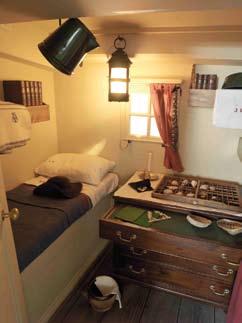

left top to bottom:
Voyage crew will sleep in hammocks on the mess deck.
Photographer A Frolows/ANMM
First class: the replica of Joseph Banks’s cabin will be available to a supernumerary passenger.
Photographer A Frolows/ANMM
Modern comforts and equipment provide our voyaging passengers with a safe and healthy experience.
Photographer J Mellefont/ANMM
helped the museum to acquire the Omai relics, three rare Polynesian war clubs collected during Captain Cook’s second exploration of the Pacific.’
During the launch of the Endeavour replica’s 2011–12 circumnavigation the museum’s director Mary-Louise Williams said: ‘We’re very excited at the prospect of Endeavour making this first voyage right around Australia and calling at so many cities and towns along the way. We wish her fair seas, following winds and every success in all the ports she visits.’
She also acknowledged those who were closely associated with the project.
‘This splendid ship was conceived right here, at an early meeting of the council of the embryonic Australian National Maritime Museum soon after its inception in the mid-1980s. It was suggested in the very first place by councillor Bruce Stannard, who served on our council until 1993. Bruce is with us today. He was a journalist who had covered Australia’s historic 1983 America’s Cup campaign and his contacts included the Cup's winner, West Australian businessman Alan Bond, who accepted the challenge to build an exact replica of the most significant ship in Australia’s history as a bicentennial gift to Australia.
‘After Mr Bond encountered financial difficulties the construction was taken over by the HM Bark Endeavour Foundation, whose long-time chairman, Michael Sharpe, is also here today. And I want to thank our old friend John Longley over in Western Australia. John has a long and loving affection for this ship. He was the leader of the team that completed it over in Fremantle and the team that managed the vessel in its earlier voyaging ventures.
‘In a completely new role, as event director for the International Sailing Federation World Championships to be held next year in Western Australia
This is truly a once in a lifetime opportunity to be part of Endeavour ’s first voyage right around Australia
in the lead-up to the next Olympic Games, John has brokered a valuable arrangement whereby the Sailing Federation will integrate the Endeavour replica into its big international regatta program.
‘I also want to thank our own team, who are putting an enormous amount of effort into preparations for the circumnavigation. Captain Ross Mattson is not only plotting the whole voyage, but has responsibility for a major docking and refit before the ship sets sail –including the replacement of 17 km of standing rigging. Ross is backed by the ship’s crew and the museum’s wider team of shipwrights. Back in the offices we have the head of our Audience Branch, Vicki Northey, who is overall coordinator of the project; voyage manager, Trish Pascuzzo and project coordinator Holly Shalders. They are contacting authorities in all the ports and are also ready to answer queries from the public and take bookings for voyage crew.’
Ms Williams added that in the coming months, the museum will be seeking to recruit volunteer guides to help staff Endeavour when it’s open for inspection in the circumnavigation ports.
While this remarkable ship is indeed an accurate replica of the original HM Bark Endeavour, powered by the wind in every respect as Cook’s ship was, the replica also carries essential concessions to the 21st century. They include twin, turbocharged diesel engines, generator sets, an electric galley, freezers and refrigeration, hot showers and safety equipment. All are hidden away in the cargo hold where Cook stored his ship’s provisions. Visitors to the ship’s authentic upper decks don’t even know that it’s there. In addition the ship has recently received a communications refit and upgrade, providing facilities ranging from improved and more reliable telephone connections to an ability to broadcast video live from the vessel at sea.
S IGNALS 92 Se PT e MB e R TO N OV e MB e R 2010 24
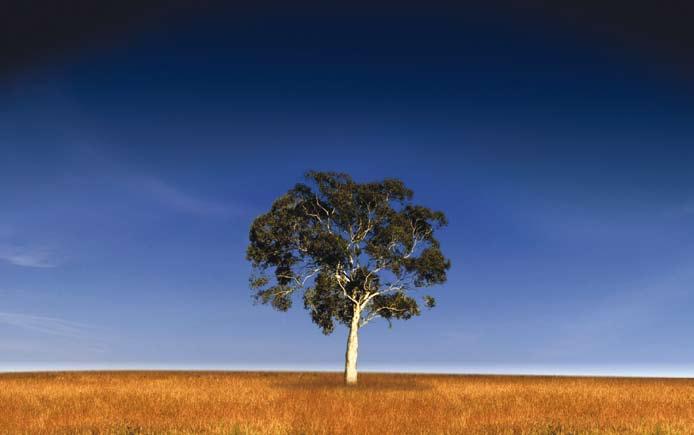

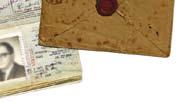
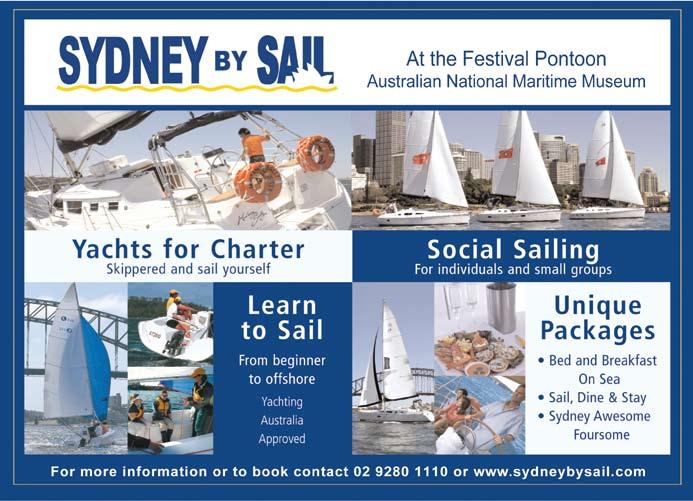
new series coming soon sbs.com.au S IGNALS 92 S e PT e MB e R TO NOV e MB e R 2010 25

















SEE IT FIRST ON News_Exclus_9letter_178x128.indd 1 9/02/2010 10:02:16 AM S IGNALS 92 Se PT e MB e R TO N OV e MB e R 2010 26
Members
News
Journalist and author Mike Carlton (centre) spoke to Members about his latest book on the loss of HMAS Perth The naval cadets are Nicola Jennings, Joshua Werfel and Alister May. Photographer J Mellefont/ANMM

Spring into action
I would like to extend a big welcome to all our new Members who have joined in recent months. I look forward to meeting you and also to catching up with some familiar faces at the museum.
Spring is a great time to get out and about. Put the museum on your to-do list, because we have some great exhibitions and events coming up. They’re listed in detail on the next pages.
One of our current exhibitions, Quest for the South Magnetic Pole, has been extended until 17 October. We will be holding a seminar on 10 October with polar adventurer Tim Jarvis and well-known author, journalist and intrepid traveller Tim Bowden. On 31 October her e xcellency Professor Marie Bashir AC CVO, Governor of New South Wales, will attend a special event with a panel of guest speakers to mark the 200th anniversary of Matthew Flinders’ return to england after charting Australia. Not to be missed.
In November we open On their own – Britain’s child migrants exploring the story of the over 100,000 child migrants sent to Commonwealth countries under various schemes. It’s a collaboration between the Australian National Maritime Museum and National Museums Liverpool, UK – see the detailed essay starting on page 2 by curator Kim Tao. Also in November, a major new international exhibition opens for the summer: Planet shark – predator or prey It will challenge people’s preconceptions about the world’s most feared predator.

You can also read in these pages about our recent announcement that HMB Endeavour will make a historic circumnavigation of Australia commencing April 2011 (page 22). Interest in taking up berths for sections of the circumnavigation is already high, so don’t delay if you want to be part of this historic sail – with special discounts for Members.
In autumn we brought you Jessica Watson and Ella’s Pink Lady, then in July we welcomed environmental crusader David de Rothschild and his vessel Plastiki, made of 12,000 recycled plastic bottles. For even more boating pleasures, join us for a trip on the Hawkesbury River mail boat and take our annual spring cruise on a heritage ferry to view the jacarandas in bloom on the Lane Cove River. And make sure you mark 16–17 October in your diary to visit the 2010 Classic & Wooden Boat Festival. This fabulous twoday celebration includes live entertainment, talks and a feast of beautifully built and lovingly restored classic craft.
Many of you will have enjoyed a meal or a drink at our harbourside Yots Café. Later in October Yots will be undergoing a major refurbishment. We will be having a Yots demolition party for Members at the end of October. Look out for that one and our many other events online at www.anmm.gov. au/membersevents. You can book online or over the phone with one of our friendly staff in the office. Just don’t hesitate as events sell out quickly!
Adrian Adam, Members manager
 below: Kate Lance, author of Alan Villiers Voyager of the Winds at her lecture and viewing of exhibition Sons of Sindbad in July. Photographer J Mellefont/ANMM
below: Kate Lance, author of Alan Villiers Voyager of the Winds at her lecture and viewing of exhibition Sons of Sindbad in July. Photographer J Mellefont/ANMM
S IGNALS 92 S e PT e MB e R TO NOV e MB e R 2010 27
right: Members rode the museum’s Daring Class destroyer Vampire back from a major dry-docking at Garden Island in July. Photographer Chris Sattler
Members events
Calendar Spring 2010
Sunday 19 Double bill: Secrets of the Tasman and the Pacific
Wednesday 22 Director’s talk: Maritime museums of the world
October
Saturday 2 For kids: Pirate, pizza and pyjama night!
Sunday 10 Exhibition farewell: Antarctic adventure
Thursday 14 Tour: Garden Island naval heritage tour
Sat 16 & Sun 17 Special: Classic & Wooden Boat Festival
Sunday 17 C&WBF Special: Captain Bligh’s mutiny
Saturday 24 On the water: Spring Jacaranda cruise
Sunday 31 Seminar: Flinders’ return – 200th anniversary
November
Sunday 7 On the water: Hawkesbury Riverboat Postman cruise
Sunday 14 Talk: What lies beneath – the Gallipoli shipwrecks
Sunday 21 Special seminar: Childhood voyages
Wednesday 24 Tour: Wharf 7 Heritage Centre behind-the-scenes
Thursday 25 Members preview: Planet Shark – Predator or prey
Sunday 28 Special: 19th Members anniversary lunch
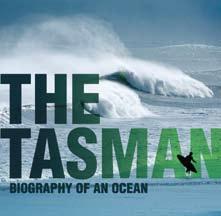
Double bill
Secrets of the Tasman and the Pacific
2–4.30 pm Sunday 19 September at the museum
The Tasman: A Biography of an Ocean Join award-winning author and adventurer Neville Peat for a talk about his new book
The Tasman: Biography of an Ocean, which tells the remarkable story of the mighty Tasman Sea. Hear about all the drama, adventure and tragedy: from the ocean’s origins, to early exploration, shipwrecks, heroic crossings and strange marine creatures, to the many colourful coastal communities of New Zealand and Australia.
The Coast Watchers ‘They watched and warned and died that we might live’
How to book
It’s easy to book for these Members events… have your credit card details handy:
• book online at www.anmm.gov.au/ membersevents
• contact the Members office: phone (02) 9298 3644 (business hours) or email members@anmm.gov.au Bookings strictly in order of receipt
• if paying by mail after making a reservation, please include a completed booking form (on reverse of the address sheet with your Signals mailout) with a cheque made out to the Australian National Maritime Museum
• if payment is not received seven days before the event your booking may be cancelled
Booked out?
We always try to repeat the event in another program.
Cancellations
If you can’t attend a booked event, please notify us at least five days before the function for a refund. Otherwise, we regret a refund cannot be made. events and dates are correct at the time of printing but these may change…if so, we’ll be sure to inform you.
Parking
Wilson Parking offers Members discount parking at nearby Harbourside Carpark, Murray Street, Darling Harbour. To obtain a discount, you must have your ticket validated at the museum ticket desk.
After Pearl Harbor, Japan swept unchecked through the Pacific. However a tiny band of brave men – known as the Coast Watchers – stayed behind enemy lines. Aided by loyal islanders, they saved countless lives (including that of future US President John F Kennedy). Hear acclaimed author Patrick Lindsey (Cosgrove – Portrait of a Leader, Kokoda Spirit, Fromelles) discuss his new book and the men who changed the course of the Pacific War.
Members $20, general $25. Includes afternoon tea and evening reception with Coral Sea wines.
September
S IGNALS 92 Se PT e MB e R TO N OV e MB e R 2010 28
Author Neville Peat tells tales of Tasman
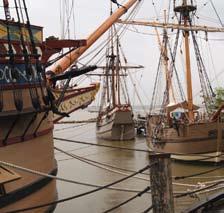

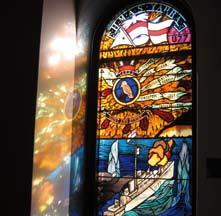
From the museum’s director Maritime museums of the world
6–7.30 pm Wednesday 22 September at the museum
e arlier this year our director Mary-Louise Williams visited some iconic US museums, including Mystic Seaport, the new maritime history exhibition at the National Museum of American History at the Smithsonian in Washington, the San Francisco Maritime Museum, and the Bishop Museum in Honolulu. She also represented this museum at the opening of the China Maritime Museum in Shanghai. Hear MaryLouise talk about these museums and view images of the guided tours she undertook.
Members $10, general $15. Includes refreshments and Coral Sea wines.
For kids
Pirate, pizza & pyjama night!
6–9 pm Saturday 2 October at the museum
Take a well-earned night off while the kids enjoy an after-dark torchlight tour of Vampire, Endeavour and the museum with our resident Pirate, Grognose Johnny. There’ll be pirate craft activities, a pizza dinner, then the kids can roll out a sleeping bag, grab a pillow and lie back in our Terrace Room to watch the fabulous family movie Peter Pan
Members child $25, general $35. Includes pizza, refreshments, movie and craft activities. Bring a torch, pillow and sleeping bag. Children will be fully supervised (parents/carers not required to stay). Ages 5–12.
exhibition farewell Antarctic adventures
2–4.30 pm Sunday 10 October at the museum
‘Men wanted for hazardous journey. Low wages, bitter cold, long hours of complete darkness. Safe return doubtful. Honour and recognition in event of success.’
– ernest Shackleton
Now there’s a job notice not everyone would be rushing to respond to. If an armchair adventure is more your style, join polar explorer Tim Jarvis and well-known journalist, author and intrepid traveller Tim Bowden to farewell our exhibition Quest for the South Magnetic Pole. In 2007, Tim Jarvis recreated Mawson’s 1912 journey to locate the South Magnetic Pole, and in 2011 he will attempt to recreate Shackleton’s 1909 expedition, sailing in a replica of Shackleton’s heroic vessel the tiny James Caird. Tim Bowden has frequently visited Antarctica and also presented the ABC documentary Breaking the Ice (1996).
Members $20, general $30. Includes reception and Coral Sea wines.
Tour
Garden Island naval heritage tour
10 am–1.30 pm Thursday 14 October at Garden Island
Don’t miss your chance to enjoy a behindthe-scenes guided tour of Garden Island heritage precinct with representatives of The Naval Historical Society of Australia. The tour will visit areas within the secure precinct, including the Kuttabul Memorial, the chapel, and heritage buildings such as the original boatshed and the top of the Captain Cook Dock. You will then have the option of taking a self guided-tour of the RAN Heritage Centre.
Members $25, general $30. Includes guided tour, entry to RAN Heritage Centre, morning tea. Requires some walking and climbing stairs. Catch the 10.10 am Watson’s Bay ferry from Circular Quay to Garden Island.
EMAIL BULLETINS
Have you subscribed to our email bulletins yet? Email your address to members@anmm.gov.au to ensure that you’ll always be advised of activities that have been organised at short notice in response to special opportunities.
right: photographer Frits Loomeijer centre: publicity still courtesy of ABC far right: photographer J Mellefont/ANMM
Replica 17th-century ships, Jamestown VA
Antarctic adventurer Tim Bowden
S IGNALS 92 S e PT e MB e R TO NOV e MB e R 2010 29
Stained glass, Garden Island chapel
Members events
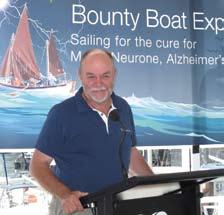
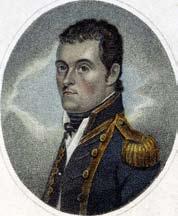

Special Classic & Wooden Boat Festival presentation
Captain Bligh’s mutiny – navigators, mariners and adventurers
3–4.30 pm Sunday 17 October in the Theatre
On 28 April 1789, Fletcher Christian cast William Bligh and 18 of his men adrift in a 23-foot open boat. The mutiny on the Bounty marked the beginning of one of the most famous open boat voyages in maritime history. Over the following seven weeks, Bligh and his men sailed more than 3,700 nautical miles, in an overloaded boat, with little food or water and no charts, from Tonga to Kupang in Timor.
In 2010, Australian adventurer Don McIntyre and three other crew relived Bligh’s nightmare by attempting to make the same voyage under similar conditions, with no charts and few supplies, in an 18th-century traditional timber whaleboat. Join Don McIntyre and ANMM Curator of e xploration Dr Nigel erskine to relive the history behind the voyage and its recreation.
FRee for Members and with Classic & Wooden Boat Festival ticket. Includes complimentary champagne. Bookings essential.
On
the water
Spring, spray and jacaranda cruise
10 am–1.30 pm Saturday 24 October on the Lane Cove River
The spring garden holds many delights including jacarandas in bloom. And there’s no better way to see them than on a leisurely cruise up the Lane Cove River aboard historic ferry Lithgow. Adam Woodhams, award-winning gardener and photographer and assistant editor of Better Homes and Gardens, will provide expert botanical and historical commentary. Includes a mystery stopover at a very special harbour location. This is one of our most popular annual events, so book early to secure your place!
Members $45, general $55. Includes brunch on board. Meet at the Festival Pontoon next to submarine Onslow
Seminar
Flinders’ return – 200th anniversary 1.30–5.30 pm Sunday 31 October at the museum
‘I call the whole island Australia or Terra Australis...’
A panel of eminent speakers will explore the life, work and legacy of Flinders: Paul Brunton (Mitchell Library), author of Matthew Flinders: personal letters from an extraordinary life; Australian map collector emeritus Professor Robert Clancy AM; and biographer Miriam e stensen, author of Life of Matthew Flinders Introduced by her e xcellency Professor Marie Bashir AC CVO, Governor of NSW. Members $30, general $40.
Includes afternoon tea and refreshments.
On the water
Hawkesbury Riverboat Postman cruise
9.30 am – 2 pm Sunday 7 November on the Hawkesbury
BOOKINGS AND ENQUIRIES
Booking form on reverse of mailing address sheet):
phone 02 9298 3644
fax 02 9298 3660 (unless indicated). All details are correct at time of publication but subject to change.
From 1801–03 english navigator and map-maker Matthew Flinders surveyed the Australian coastline in his ship Investigator He was the first european to closely circumnavigate the continent, and is credited with giving it the name ‘Australia’. In October 2010 we will commemorate the bicentenary of Flinders’ return to england. This seminar highlights the famous chart completed by Matthew Flinders in 1804 while imprisoned in French Mauritius. The chart represents his voyages around the Australian coastline between 1798 and 1804, and contains the first known use of the name ‘Australia’.
Step aboard a traditional timber ferry and travel up the longest river on Australia’s east coast. The Riverboat Postman has been providing an essential mail service to river communities since 1910. In the early days of settlement, the Hawkesbury River was the lifeline of trade between farming communities and the struggling colony of Sydney. Today it remains a vital link to unique water-access only settlements along this magnificent waterway. Stop at Dangar Island for oysters and a light lunch. Spend a leisurely afternoon and return at your own pace on the hourly service from the island.
Members $65, general $75. Meet at Brooklyn Public Wharf. Take a train to Hawkesbury River Station. Includes lunch and ferry trip to and from Dangar Island.
Don McIntyre – Bligh open-boat adventurer
far left: photographer J Mellefont/ANMM centre: ANMM Collection left: photographer Andrew Davey
Matthew Flinders, lithograph 1814
S IGNALS 92 Se PT e MB e R TO N OV e MB e R 2010 30
Cruise Hawkesbury River with the postman



Illustrated talk
What lies beneath –the Gallipoli shipwrecks
2–3.30 pm Sunday 14 November at the museum
The inaugural 2010 expedition to ANZAC Cove Suvla Bay, Gallipoli, undertook the first comprehensive underwater cultural landscape survey of the 95-year-old Gallipoli battlefield. An international team led by e xpedition Director Tim Smith included Mr Selcuk Kolay OAM, discoverer of the AE2 submarine wreck in 1998, and professional underwater photographer Dr Mark Spencer, who spent two weeks undertaking the survey. They discovered what appear to be at least two previously unseen shipwrecks from the campaign, as well as numerous other artefacts. Join Tim Smith and Mark Spencer to learn more about the project and view some remarkable images and footage of the underwater battlefield.
Members $15, general $20. Includes refreshments and Coral Sea wines.
Special seminar
Childhood voyages: ships, sea-spray & recollections of children at sea
1.30–5 pm Sunday 21 November at the museum
From the late 19th century, Britain operated child migration schemes that sent more than 100,000 children across the world to Canada, Australia and other Commonwealth countries. Journalist and author Alan Gill (Orphans of the Empire) will provide an overview of the history of child migration in Australia, and author and maritime historian Peter Plowman will talk about the ships that carried these children to Australian ports. We’ll also hear from four former child
migrants: eric Leonard, Fairbridge Farm Molong (arrived circa 1936), Peter Bennett, Fairbridge Farm (arrived 1945), Shirley Ronge, Barnardo’s (arrived 1950) and Phillip Simpson, Methodist School (arrived circa 1950), as they share recollections of their sea voyages from england to Australia, illustrated with images from their private collections.
Members $30, general $40. Includes afternoon tea and evening reception.
Tour
Wharf 7 Heritage Centre behind-the-scenes
10.30 am–1 pm Wednesday 24 November at Wharf 7
Come behind the scenes in our special Wharf 7 storage areas not usually open to the public, and see where many of the objects from the National Maritime Collection are housed. Visit our preservation laboratory where ANMM Conservation Manager Jonathan London will explain how artefacts are preserved and prepared for exhibition, then view some of the treasures from the Vaughan evans library.
Members only, $15. Includes light lunch. Limited places. Meet in Wharf 7 foyer.
Members preview
Planet Shark: Predator or prey
6–8 pm Thursday 25 November at the museum
Created by Grande e xhibitions and a team of experts in marine biology, aquaria, and oceanographic cinematography, Planet Shark – Predator or prey challenges our fears and misunderstandings about the plight of this most feared of predators. The exhibition includes an extensive collection of pristine fossil specimens, shark jaws, dive cages, hunting and commercial fishing equipment, and full-size casts of a dozen different species. There are also items from famous Hollywood movies, media propaganda, stunning audio-visuals, thematic lighting and interactive multimedia displays.
Join ANMM curator Dr Stephen Gapps for an introductory talk and viewing.
Members $15, general $20. Includes refreshments and Coral Sea wines.
Special 19th Members anniversary lunch
11.30 am–2.30 pm Sunday 28 November in the Terrace Room
Book early for our next anniversary lunch with museum director Mary-Louise Williams, the new chairman of our council Peter Dexter, and special guest speaker, author and journalist Peter Fitzsimons. enjoy your fellow Members’ company and a delicious three-course lunch from Bayleaf, our awardwinning caterer, accompanied by Coral Sea wine and James Squire beer. The annual anniversary lunch is a fine tradition and a gastronomic event…don’t miss it!
Members $85, general $95.
Meet in the Museum foyer.
right: reproduced courtesy Dr Mark Spencer centre: reproduced courtesy State Library of Western Australia far right: photographer Zara Collins/ANMM
54 metres below Anzac Cove
Bound for Fairbridge Farm School 1950
S IGNALS 92 S e PT e MB e R TO NOV e MB e R 2010 31
Anniversary lunch 2009 Joan and Bob Killingsworth
What’s on spring 2010 events

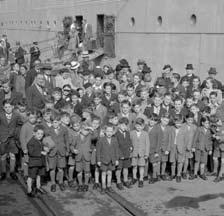
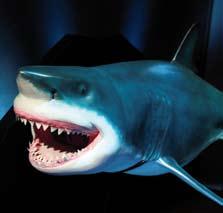
History Week
Who do you think you are!
10–11 am Monday 6 September
Tour the museum and view the changing faces of those who shaped Australia –Indigenous people, early explorers, convicts, first immigrants, diggers on the goldfields, maritime workers, child migrants, post-war migrants and boat people. See how dress and hairstyles of our serving men and women and competitive swimmers changed over 100 years!
FRee. Includes morning tea. Bookings essential 9298 3655 or email bookings@anmm.gov.au
Cruise Forum
Macquarie’s Sydney from the harbour to Hyde Park
10 am–3 pm Thursday 9 September Sydney under Governor Macquarie developed around the harbour front and along Macquarie Street to Hyde Park, which he gazetted as a ‘common’ in 1810. Dr Ian Hoskins (Sydney Harbour: A History) will describe the foreshores of Macquarie’s Sydney, and Maureen Fry will look at the buildings further back from the water. Then board a heritage ferry for a cruise with commentary around related sites including Mrs Macquarie’s Chair and a picnic in the Botanic Gardens. Join Maureen for a guided walk along Sydney’s most historic street. On return, take a guided tour of our Macquarie’s Light exhibition
$65 (concession $59). Includes cruise, picnic lunch and tour. Bookings essential We A 9264 2781
Quest for the South Magnetic Pole
10 am–12.30 pm Thursday 16 September
A century ago, Mawson’s Northern Party planted the British flag as close as they could to the South Magnetic Pole. Physicist Dr Phil Dooley (University of Sydney) explains the science of magnetism and why scientists and explorers were so keen to reach this constantly shifting target. State Library curator Stephen Martin ( A History of Antarctica and Penguin) evokes the extreme conditions endured by these polar adventurers – how they lived, worked and survived in such a harsh environment. Diana Patterson (The ice beneath my feet) describes her year in Antarctica in charge of the Mawson Research Base. Then enjoy a viewing of the exhibition and a free screening of Mawson: Life and Death in Antarctica
$45. Includes morning tea. Bookings essential We A 9264 2781
The Leaving of Liverpool: Britain’s child migrants
10 am–12 noon Thursday 25 November
Historian Professor Geoffrey Sherington discusses the background to British child migration schemes; author and former Sydney Morning Herald journalist Alan Gill details the research methods and case studies he uses in his writing on this subject; and former child migrant Peter Bennett recalls some of the early years at Fairbridge Farm, Molong. Then take a guided tour of the exhibition On their Own and view an episode of The Leaving of Liverpool
In association with National Museums Liverpool, UK. $45. Includes morning tea. Bookings essential We A 9264 2781
Sharks – predator or prey?
10 am–12 noon Thurday 9 December Journey into the world of the shark – one of the most misunderstood animals on earth, and for the first time in 450 million years, under threat. Amy Wilkes (Aquarist, Sydney Aquarium) talks about strategies of shark reproduction, and Professor Robert Harcourt (Macquarie University), discusses the ecology of sharks common to Australian waters. Then view our Planet Shark exhibition, featuring three giant screens projecting some of the most stunning sequences of sharks ever filmed. e xhibition made available by Grande e xhibitions of Australia. $45. Includes morning tea
Special group rate for school holiday activities (opposite)
For 10 children or more, $7 per child for a fully organised program of activities that includes:
• all museum exhibitions
• all children’s daily activities
• entry to destroyer HMAS Vampire, submarine HMAS Onslow and tall ship HMB Endeavour replica
• FREE entry for 2 adults/10 children
• FREE bus parking
Note $4 extra/child for 1874 tall ship James Craig
Bookings essential.
Book early to ensure your space!
Ph 9298 3655 Fax 9298 3660 email bookings@anmm.gov.au
far left: photographer J Carter/ANMM centre: courtesy State Library of Western Australia, The Battye Library left: reproduced Courtesy of Grande e xhibitions Australia
Sharks – Predator or prey?
Post-war child migrants arrive Fremantle 1947
S IGNALS 92 Se PT e MB e R TO N OV e MB e R 2010 32
entrance to the museum’s Passengers exhibition
Kids events
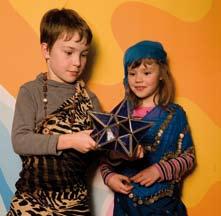
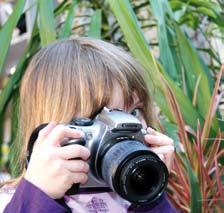
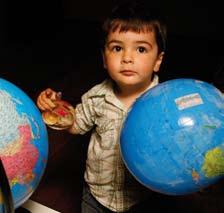
Spring school holidays 26 September–10 October 2010
Kids on Deck
Travels with Sindbad
Children 5–12 years
10 am–4 pm (hourly sessions) daily during school holidays
e xplore the world of Sindbad the Sailor. Use block-printing techniques to design a tea-towel to take home. Create your own African body-painting designs on paper, discover the fragrant world of spices from Zanzibar, and paint your own decorative tile inspired by Islamic art.
$7 per child or FRee with any purchased ticket. Adults/Members FRee
Kids on Deck
Henna hand-painting
Children 5–12 years
10.30 am–1.30 pm
Sunday 26 September
Have your hand painted with cosmetic coloured powder in beautiful designs!
Included in your Kids on Deck ticket
Workshops from the Arabian Nights
Ages 8–12 years
10.30 am, 12 noon OR 1.30 pm
Monday 27 September–Friday 1 October
Be creative in a series of music, dancing and storytelling workshops celebrating cultures from the Middle e ast to the e ast African coast.
Included in Kids on Deck ticket. Limited places – collect your session sticker on arrival. Visit www.anmm.gov.au for details
Youth photography workshops
Ages 8–14 years
9.30 am OR 1.30 pm
Friday 8 October
Be inspired by the images in our Sons of Sindbad exhibition. Learn to use professional camera equipment in an outdoor photo shoot around the museum. Your best shot is printed and framed to take home, plus a CD of all your photos. Presented by Spitting Image.
$45 Members $40 (includes print and CD). Bookings essential 9298 3655
During school term
Family fun Sundays!
Kids on Deck
Travels with Sindbad
Children 5–12 years
11 am–3 pm (hourly sessions) every Sunday during term
e xplore the world of Sindbad the Sailor. Use block-printing techniques to design a tea-towel to take home. Create your own African body-painting designs on paper, discover the fragrant world of spices from Zanzibar, and paint your own decorative tile inspired by Islamic art.
$7 per child or FRee with any purchased ticket. Adults/Members FRee
Kids on Deck
Shipboard games
Children 5–12 years
11 am–3 pm
Sunday 28 November
Play shipboard games in Kids on Deck. Quoits, board-games and more!
$7 per child or FRee with any purchased ticket. Adults/Members FRee
Mini Mariners
Children 2–5 years + carers 10–10.45 am & 11–11.45 am (2 sessions) every Tuesday during term
7, 14, 21 September
– Boats on the Harbour
Join the crew as we row, row, row through the stormy seas singing songs as we go. Stories, games and craft.
12, 19, 26 October
– Sail around the World
Grab your passport and get set for a sailing adventure around the world.
2, 9, 16, 23, 30 November
– By the Seashore
Touch and feel some special objects from the seashore and create some craft to take home.
$7 per child. 1st adult/Members FRee Booked playgroups welcome. Bookings essential 9298 3655. Please note this program is not offered during the school holidays and for safety reasons is held inside the museum.
Free family movie!
1.30 pm daily during holidays 1.30 pm every Sunday during term
Visit www.anmm.gov.au for full program
See the museum’s fleet
Buy a Big Ticket, see our fleet, and enjoy all kids’ daily activities!
DATE FOR YOUR DIARY
Tuesday 7 December
Mini Mariners end of year concert!
right: photographer A Frolows/ANMM centre: courtesy Spitting Image Photography far right: photographer A Frolows/ANMM
Kids on Deck – Sindbad and Arabian Nights
Mini Mariners set sail
Youth photography workshops
S IGNALS 92 S e PT e MB e R TO NOV e MB e R 2010 33
exhibitions
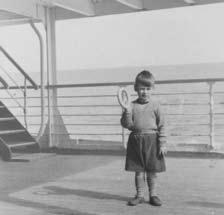


On their own –
Britain’s child migrants
10 November 2010–3 April 2011
South Gallery
From the 1860s onwards more than 100,000 British children were sent to Commonweath countries including Australia, through child migration schemes that dramatically changed their lives. Most embarked alone on long ocean voyages that carried them from the familiar to the unknown, to mixed fortunes and sometimes to suffering and sorrow.
A collaboration between the ANMM and National Museums Liverpool, UK

Quest for the South Magnetic Pole
Until 17 October 2010
Gallery One
For over 150 years explorers risked their lives in one of the planet’s most hostile environments to search for the South Magnetic Pole. Quest investigates the science of magnetism, and the extraordinary risks and extreme conditions endured by these daring polar adventurers in their race to reach a constantly shifting target. It was Australian scientist Charlie Barton who ultimately came closest in 2000.
An exhibition from the South Australian Maritime Museum and the South Australian Museum

Sons of Sindbad –
The photographs of Alan Villiers
Until 17 October 2010
South Gallery
Alan Villiers’ photographs of his voyages aboard Arabian dhows in 1938–39 capture age-old Indian Ocean sailing traditions, the great skills and hardships endured by sailors and pearl divers, and what he thought were the ‘last days of sail’ in the Red Sea, the Persian Gulf and the coasts of Arabia and east Africa.
Produced in collaboration with the National Maritime Museum, Greenwich, UK, with the assistance of William Facey and Grace Pundyk

Macquarie’s Light
Until 7 November 2010
North Gallery
2010 marks the 200th anniversary of Lachlan Macquarie becoming fifth Governor of New South Wales. This exhibition explores the history of the Macquarie Lighthouse from the original design commissioned by Macquarie in 1818, to the present design built by the NSW Colonial Government in 1883, with fascinating views of its changing setting over time.

Intertwined journeys –Tu Do and the Lu family
Until 14 November 2010
Tasman Light
The remarkable story of the Lu family, who arrived in Australia in 1977 on the Vietnamese refugee boat Tu Do, is documented in 12 photographs by Michael Jensen and Andrew Frolows. The museum acquired Tu Do – meaning Freedom – in 1990 and has worked closely with the Lu family to record their experiences and restore this historic vessel.
Freshwater Saltwater – Aboriginal and Torres Strait Islander prints
17 November 2010–20 February 2011
Tasman Light
A selection of 10 prints from our Sail Away travelling exhibition program.
Vivid representations of marine life and environments celebrate Indigenous culture and the struggle of these communities for justice and land and sea rights.

Planet shark – Predator or prey
26 November 2010–27 February 2011
Gallery One & North Gallery
Journey into the world of the shark, one of the most misunderstood animals on earth. Sharks have been predators for more than 450 million years in our oceans making them among the most successful species on earth. Today there are more than 350 species of shark swimming in our oceans and for the first time they are under threat. This e xhibition has been made available by Grande e xhibitions of Australia
On their own – Britain’s child migrants
Sons of Sindbad – the photographs
far left:
reproduced courtesy of Sydney Lee centre:
photographer Alan Villiers
reproduced courtesy National Maritime Museum Greenwich UK left: untitled
(Dugong) 1994 Susan Wanji Wanji
Freshwater Saltwater – Indigenous prints
S IGNALS 92 Se PT e MB e R TO N OV e MB e R 2010 34
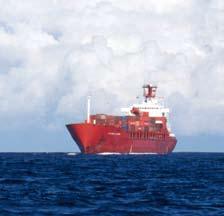
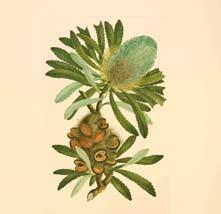
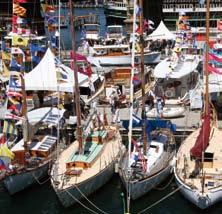
David Moore –Portraits of a shipping company
USA Gallery
World-renowned Australian photographer David Moore was commissioned by Columbus Line to create photographic portraits of their shipping activities. The company began operations between North America and Australia/New Zealand in 1959 and was the first company to regularly schedule a containerised shipping service.
HMB Endeavour replica
Open daily 10 am–4 pm
Adults $18, child/concession $9, family $38. Members FRee
Other ticket combinations available. enquiries 9298 3777
Barque James Craig (1874)
Daily Wharf 7 (except when sailing) Various museum ticket packages (discount for Members).
Check www.shf.org.au for details
Travelling exhibitions
Exposed! The story of swimwear
Until 7 November 2010
Museum of the Riverina Wagga Wagga NSW 20 November 2010– 6 February 2011
Newcastle Regional Museum NSW Exposed! places Australian swimwear in a global context of design, swimming history, and popular culture.

Sail Away program

Joseph Banks and the flora of the Australian east coast
Until 19 September 2010
Lake Macquarie City Art Gallery NSW
25 September–7 November 2010
Gold Coast City Art Gallery QLD
8 December 2010–27 February 2011
Redcliffe Museum QLD
engravings of Sydney Parkinson’s original botanical drawings from Cook’s first voyage.
Little Shipmates – seafaring pets
2 September–11 October 2010
Museum of the Riverina Wagga Wagga NSW
16 October 2010–23 January 2011
Eden Killer Whale Museum NSW
Shipboard pets recorded by Sydney photographer Sam Hood over 50 years.
Freshwater Saltwater – Aboriginal and Torres Strait Islander prints
21 August–24 October 2010
South Australian Maritime Museum
Marine art celebrates Indigenous culture and struggle for justice, land and sea rights.
Steel Beach – ship breaking in Bangladesh
2 September–11 October 2010
Museum of the Riverina Wagga Wagga NSW
Andrew Bell’s photographs of shipbreaking on the Bay of Bengal.
The Classic & Wooden Boat Festival is a fantastic weekend for everyone! This year it’s going to be bigger than ever, with more than 100 superb boats at our wharves, a festive marketplace selling all things nautical, plus an outstanding display of boating products. Old favourites such as the hotly contested Deckhand’s Linethrowing Contest will return, as well as new activities and demonstrations that will keep you enthralled all day. See Australian icons and Sydney Harbour classics galore, plus a host of activities and events including:
• hundreds of magnificent visiting vessels – from graceful yachts to streamlined speedsters, dories, dinghies, skiffs and canoes
• demonstrations by skilled traditional maritime craftsmen, including blacksmiths, rope-knotters, caulkers and sail-makers
• heritage boat rides
• a giant model display
• a working marine engine display
• the famous Deckhand Line-throwing Contest
• specialty food and refreshment stalls
Adult $18, child/concession $9, family $40. Become a Member and get in FRee!
David Moore – Portraits of a shipping company
right: photographer David Moore Hamburg Süd Collection centre: Castanospermum australe © Natural History Museum London far right: photographer A Frolows/ANMM S IGNALS 92 S e PT e MB e R TO NOV e MB e R 2010 35
Joseph Banks and Australian east coast flora Classic & Wooden Boat Festival
Lots of Lloyd’s
shipping information for the world
The name Lloyd’s is synonymous with shipping.
Lloyd’s List is the industry bible, and Lloyd’s Register celebrates 250 years this year. Do you know the difference? Manager of the museum’s Vaughan evans Library, Frances Prentice, tells the story of these maritime institutions and outlines what they have to offer for researchers and nautical enthusiasts alike.

Many researchers who contact us at the museum’s public research facility, the Vaughan Evans Library, ask for Lloyd’s Register or Lloyd’s List by name – often without any real knowledge or experience of using these resources, but simply because something in our collective consciousness tells us that if you want to find reliable information on ships or shipping, Lloyd’s is it. Why is this so?
From their origins in Lloyd’s coffee house in the City of London during the 17th century, through to the informationladen online environment of the 21st century, the publications of Lloyd’s Register and Lloyd’s of London continue to form the daily working tools of the shipping industry. Their legacy is an archive of materials that museum librarians around the world use every day.
The emergence of the 17th-century coffee house was part of a burgeoning social and commercial movement associated with the growth of trade and ideas during the European enlightenment. Coffee drinking had spread to Europe from the Middle East via Venice, and the first such institution opened in London in 1652. English coffee houses multiplied rapidly, open to customers regardless of social status and thus associated with equality and republicanism. Charles II (1630–1685) tried to suppress them as ‘places where the disaffected met, and spread scandalous reports’. Different coffee houses became meeting places for like minds – Whigs or Tories, intellectuals or men of fashion, lawyers or businessmen.
Lloyd’s of London
Edward Lloyd established his coffee house in 1688 in Great Tower Street, London, moving to 16 Lombard Street in 1691. It was a favoured haunt of merchants, ships’ captains, marine underwriters and others connected with shipping, where they met to carry out the business of the day and exchange the latest news. Insuring ships and their cargoes was carried out by wealthy individuals who each took a share of a risk, signing their names one beneath the other on the policy, with the amount they agreed to cover. For this reason they became known as ‘underwriters’.
Lloyd himself was not involved in insurance, but provided premises and a variety of services to enable his clientele to carry on their business of insuring ships and their cargoes. Since he heard a lot of news in the course of his daily trade, he began to provide a free shipping information service to his customers. Originally circulated in the form of a printed news-sheet, The List (as it was originally known) eventually grew into Lloyd’s List – a daily newspaper of reliable shipping intelligence sourced from around the globe. Not only was this one of the very earliest news publications, today it is the world’s longest-running daily newspaper, unrivalled in its geographic coverage.
left: Detail from a modern depiction of Lloyd’s coffee house in London, by Derek Lucas 1960s. It hangs in the Liverpool, UK, office of Lloyd’s Register group of companies.
S IGNALS 92 Se PT e MB e R TO N OV e MB e R 2010 36
250Celebrating 250 years
below: Lloyd’s Subscription Room by Thomas Rowlandson, aquatint, 1800. By the end of the 18th century the underwriters had moved from Lloyd’s coffee house to their own premises in the Royal exchange. In booths on the right patrons are drinking coffee. Reproduced courtesy of the National Maritime Museum, Greenwich, London
In 2010 Lloyd’s Register celebrates 250 years since the establishment of a Society for the Registry of Shipping by patrons of edward Lloyd’s London coffee house in 1760. The museum is displaying historic objects from Lloyd’s Register, the Australian National Maritime Museum collection and the Vaughan evans Library, in the Commerce exhibition until December.
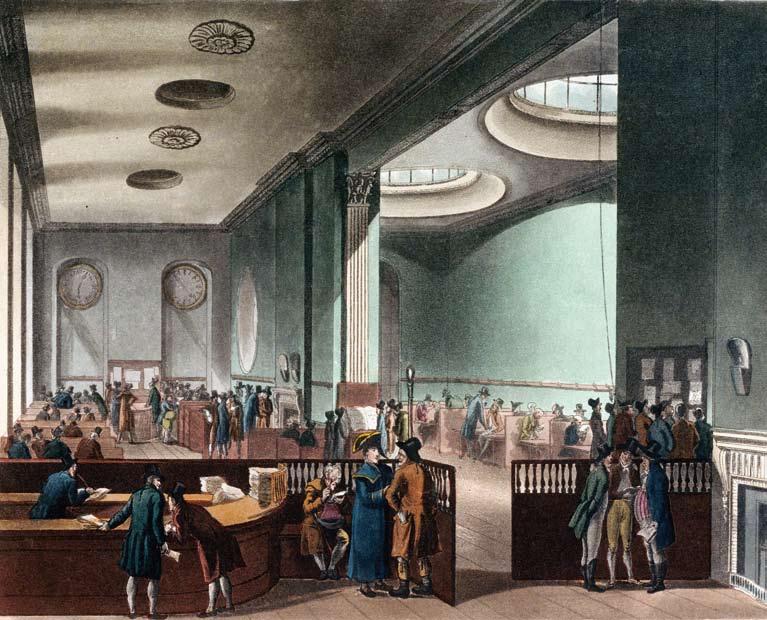
S IGNALS 92 S e PT e MB e R TO NOV e MB e R 2010 37
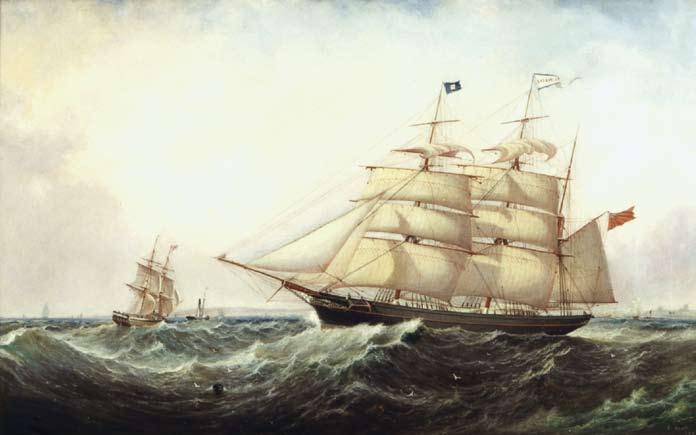
above: The iron barque Lizzie Leslie was the first vessel to receive the new class notation +100A1 in 1870. Painting of the Lizzie Leslie off Tynemouth by John Scott, 1867.
Courtesy of Lloyd’s Register, London
below: Illustration from Lloyds’ Register showing Endeavour being renamed Lord Sandwich
bottom: example of Lloyd’s Register from 1878. It shows the Formée or Maltese Cross adopted in 1853 to indicate that a vessel has been built under Lloyd's Register special survey. There’s a reference to Clan Macleod, the iron-hulled barque later renamed James Craig, restored by Sydney Heritage Fleet and moored outside the museum’s Wharf 7 Maritime Heritage Centre.

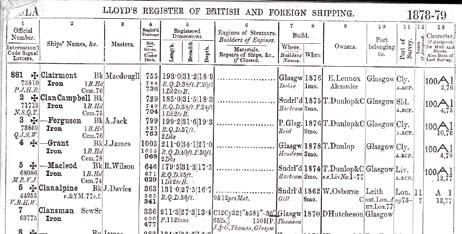
below: Captain Robert Basil Vincent McKilliam (1861–1934), whose career is documented in Lloyd’s Captains Register. Passengers and visitors enjoyed the company of the lifetime bachelor. McKilliam Collection, ANMM, gift from descendants of the captain.
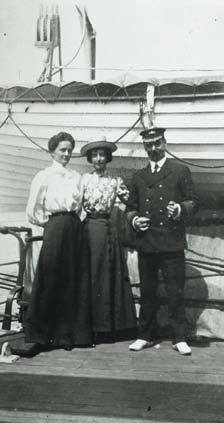
S IGNALS 92 Se PT e MB e R TO N OV e MB e R 2010 38
Lloyd's Register
In 1760, the patrons of Lloyd’s London coffee house (by this time no longer in the hands of the Lloyd family) formed the Society for the Registry of Shipping to classify merchant ships according to their condition. Classification was carried out by a small team of surveyors, many of whom were retired sea captains – and so Lloyd’s Register was born. First printed as the Register of Ships in 1764, its aim was to give underwriters, shipbrokers, shipowners and merchants a reliable idea of the condition of the vessels they insured and chartered. It was the first – and is still the foremost – ship classification society in the world.
To appear in the Register, vessels were required to meet a minimum standard of design, and quality of construction. Ship hulls were graded on a lettered scale, ‘A’ being the highest. The condition of ship fittings – masts, rigging, and other equipment – was originally indicated by G, M or B, standing for Good, Middling or Bad. This was replaced some 10 years later with a numbering system,‘1’ being the highest. Thus the expression ‘built to Lloyd’s A1’ derives from the top classification, a term which first appeared in the 1775–76 edition of the Register, and is still widely recognised as a symbol of quality today.
The Lloyd’s Register Class mark is also believed to be the first use of a quality mark in the world. It was Lloyd’s Register surveyor Captain Thomas Menzies who in 1853 suggested the use of the Formée or Maltese Cross symbol to indicate that a vessel had been built under Lloyd's Register special survey anywhere in the world.
What will you find in Lloyd’s List and Lloyd’s Register?
Lloyd’s List is a daily record of shipping movements reported from around the world. Entries are usually brief, but contain the vessel’s name, master’s name, ports of call and dates. The list and its associated index can be used to track a vessel’s career over a period of years, all in one source.
Although it can be a little hard to use at first and searches can be time-consuming, once mastered the List almost always delivers good results. It’s particularly useful for difficult research tasks, for instance when you don’t have access to shipping intelligence from local newspapers, or if you have incomplete information about dates to narrow your newspaper research.
Our collective consciousness tells us that if you want reliable information on ships or shipping, Lloyd’s is it
are arranged alphabetically by name within a series of years, and give you a date and place of birth, date of qualification, type of certificate, plus a list of engagements with name of ship, official number and tonnage.What you won’t find in these publications are shipping company records, crew lists, passenger details, or photos of ships’ passengers or crew.
Arrivals, departures, wrecks, strandings, and speakings between vessels – the term for ships encountering each other at sea and pausing to exchange news and perhaps mail – are all recorded. Even reports of flotsam and jetsam from wrecks merit a mention. Over time the amount of information reported increases, and by the mid-19th century for large UK ports like London or Liverpool, there are summary tables listing vessels arriving and departing with destinations over several months. These tables are a convenient way of seeing how many vessels traded to specific ports over time and also give the name of the dock where the vessel was berthed and country of ownership. Later issues also contain advertisements.
Lloyd’s Register is an annual publication that lists ships alphabetically by name. Generally you will find information about a vessel’s construction, such as type, tonnage, date and place of build, as well as the owner, master, and place of registry. Again, this information gradually becomes more detailed in the latter half of the 19th century. Included in some editions, and later published separately, are comprehensive rules for the classification of vessels. As a general rule, a vessel will remain in the Register until it is sunk, wrecked, broken up, hulked, scrapped or otherwise comes to an end.
Compiled by Lloyd's of London, Lloyd’s Captains Registers contain details drawn from official sources relating to captains and masters in the merchant marine. This is a good source of information for UK-based captains, although not totally comprehensive for colonial engagements and for those who gained their qualifications in Australian ports. Our holdings are on microfilm: some of the registers are handwritten and the quality varies greatly from reel to reel. The originals are held at the Guildhall Library in London as part of their manuscripts collection. The registers
Real-life examples of major social, technological and economic developments can be found in these pages: the expansion of commercial shipping; the development of shipbuilding in Britain and North America; changes in trade routes and supply of commodities; the introduction of new technologies such as clipper ships, steam engines, iron and steel shipbuilding; and improvements in the speed of communications, are all documented. Standards, ratings, quality assurance, risk assessment, business intelligence and specialised information services are now routinely part of the workplace environment, but these ground-breaking ideas were adopted early on by the shipping industry.
How do we use Lloyd’s publications at the museum?
Lloyd’s Register
As part of the Search for Endeavour project conducted from 1999 onwards by this museum in collaboration with the Rhode Island Marine Archaeology Project (RIMAP), museum maritime archaeologist Kieran Hosty undertook background research to investigate and document the career and ultimate fate of James Cook’s vessel. An integral part of this research involved using Lloyd’s Register of Shipping
After Cook returned from his first voyage, Endeavour made three voyages as a stores ship before being paid off by the British Admiralty in 1775. The ship entered the Register of 1775–76 renamed the Lord Sandwich and remained in the register until 1779, after which the entry disappears. The 360-ton Lord Sandwich is believed to have been one of 13 chartered transports scuttled by the British in 1778 to blockade Newport’s outer harbour against an attacking French fleet during the American War of Independence. While only the lowest timbers of these scuttled vessels survive in the silt on the harbour floor, it was possible to use the key dimensions and tonnages of the Endeavour derived from Lloyd’s Register to narrow down the search and identify those wrecks most likely to be Cook’s sturdy collier. Although it was not
S IGNALS 92 S e PT e MB e R TO NOV e MB e R 2010 39
possible to confirm that the team had indeed found Endeavour, they were able to say with certainty that it was a pre-1800 wooden sailing ship of approximately the same tonnage and construction as James Cook’s ship. [See Signals June 1999, p. 28]
Lloyd’s List
Lloyd’s List is often used to assist with shipwreck research, particularly to compare with other sources of information when trying to determine the location of a wreck site and the circumstances in which it occurred. It was one of the primary resources used by this museum’s USA Gallery curator Paul Hundley to help document and interpret the objects he had acquired for the USA Gallery relating to the American barque Julia Ann
The 350-ton Julia Ann had sailed from Sydney bound for San Francisco in September 1855 with a cargo of Newcastle coal and 42 passengers, but was wrecked on a Polynesian reef at the westernmost tip of the Society Islands, 400 nautical miles west of Tahiti. The shipwreck has

all the ingredients of a good movie script. Many of the passengers were members of the Mormon Church returning home to Utah where they had been summoned for the second coming of their late founder Joseph Smith. The 41 passengers and crew were stranded on the tiny uninhabited Scilly Island (now called Manuae) for two months before being rescued. Paul and other members of the ANMM maritime archaeology program also used this research to mount a successful international expedition in 1997, which located and recorded the wreck site and recovered remains of the ship. [See Signals June 1996, p. 9]
Lloyd’s Register of Yachts
According to David Payne, curator of the museum’s Australian Register of Historic Vessels (ARHV), the annual publication Lloyd’s Register of Yachts has proven to be a very useful resource. ARHV records historic Australian craft and their stories, and yacht register entries have provided a great deal of useful information for many of the yachts and motor craft listed.
Lloyd’s coffee house in London was a favoured haunt of merchants, marine underwriters and others connected with shipping
Details about the designer, builder, engine and changes of ownership help to flesh out a craft’s background and can be crossreferenced with information from other sources to add to the vessel’s story. For example, among the many owners for the 1897 gaff-rigged racing yacht Sayonara were the Wallace brothers of Melbourne, who are delightfully listed in Lloyd's Register of Yachts owners’ pages as residing at the Esplanade Hotel, St Kilda –a detail which corresponds neatly with their title as ‘gentlemen’ in another official record of the time!
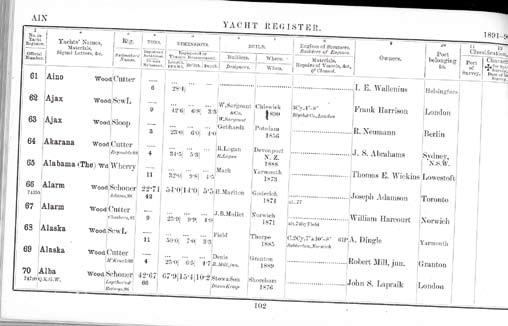
left: extract from the 22 March 1856 issue of Lloyd’s List reporting news of the shipwreck of American barque Julia Ann above: example of Lloyd’s Register of Yachts from 1891. The museum’s oldest vessel, the 1888 racing cutter Akarana (right), is listed. The yacht sails here shortly after her reconfiguration in 1997–98, using data drawn from the Register.

S IGNALS 92 Se PT e MB e R TO N OV e MB e R 2010 40
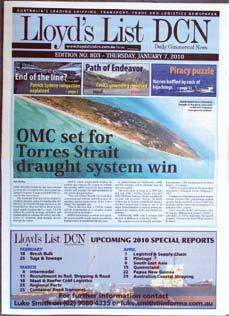
Vessel dimensions can help to confirm a craft’s particulars, or to show evidence of later modifications such as sail area or changes in handicap rating. Dimensions
can also be helpful in restoration projects, such as the major restoration of this museum’s oldest vessel, the 1888 gaff cutter racing yacht Akarana, undertaken by the museum during 1997–98. The yacht had been much-modified during her long life. The length measurement quoted in the 1901 Register of Yachts, in this instance taken from the sternpost which remained in place, helped to confirm the true length of the overhanging stem. Another set of very colourful pages in Lloyd’s Register of Yachts that have proven very helpful are the owners’ flags from the 1890s. Their distinctive patterns have helped to identify otherwise unnamed yachts in historic black-andwhite images from the same period.
Lloyd’s List DCN
Lloyd’s List DCN is an Australian national newspaper of shipping, transport and trade news published from its Sydney CBD headquarters, with a bureau in Melbourne. In 1993 Lloyds List extended its international scope by starting up an Australian newspaper, Lloyd’s List
Australian Weekly (LLAW) in competition with Daily Commercial News (DCN), an Australian shipping and trade journal founded in 1891. A takeover of DCN by the parent company of LLAW, completed in 1999, resulted in the new title. Lloyd’s List DCN remains a totally subscribed weekly Australian newspaper with a daily e-mail newswire service.
In 2010 Lloyd’s Register celebrates 250 years of continuous involvement in maritime standards and assessment. Well over three centuries after it began, Lloyd’s List is the world’s largest independent supplier of shipping information services, providing 24-hour coverage and analysis of all aspects of maritime issues – and it’s now available online at www.lloydslist.com/ll. So if you should take your WiFi laptop down to your local café or Yots Café Bar here at the museum to do a spot of nautical research in Lloyds’s resources, you’ll now understand that working out of a coffeeshop is not such a modern innovation after all!
Our holdings at the Vaughan Evans Library
Lloyd's of London and Lloyd's Register publications are the cornerstones of many maritime research collections and are among the most used resources. While relatively easy to access in the UK, they can be more difficult to locate in Australia and New Zealand. Here are some of our key holdings:
Lloyd’s Register of Shipping 1776–1880 (microfilm) 1880– (hardcopy) (incomplete)
Lloyd’s List 1741–1826 (incomplete) 1827–1900 (microfilm)
Lloyd’s List Index 1838–1900 (microfilm)
Lloyd’s Register of Yachts 1891, 1901, 1906, 1914–16, 1918–19, 1923, 1927, 1929, 1936, 1947–55, 1974
Lloyd’s Captains Register 1851–1947 (microfilm)
More information
Lloyds Register Infosheet No. 31: Lloyd’s Register (1 August 2008): www.lr.org/NR/rdonlyres/F0A01693-e AFF44Ce-8C47-0e5914F00A7D/85199/ Info31HistoryofLloydsRegister1.pd
Lloyds Register Infosheet No. 36: The Maltese Cross (4 August 2003): www.lr.org/NR/rdonlyres/B199FCBD-6F e A44FB-8726-F607A72326e8/56302/ Info36Maltesecross.pd
Blake, George, Lloyd’s Register of Shipping, 1760–1960, illustrated by David Knight, London, Lloyd’s Register of Shipping, 1960. 387.20601 LLO
A standard work covering the history of Lloyd’s Register of Shipping.
Lloyd’s Register Historical Research Service: www.lr.org/Industries/Marine/ Services/Shipping+information/ Historical+research+service.htm
This is a research service offered by Lloyd’s Register Information Centre, who will research ships’ histories and also search for yacht plans/survey reports for a fee.
The Lloyd’s Marine Collection: This collection is held at the Guildhall Library in London. Here is a link to the page from their website explaining what is included and how to access it: www.lloyds.com/About_Us/ History/Marine_collection.htm
The Vaughan evans Library also holds a printed guide to this collection: Guide to the Lloyd’s Marine Collection and related marine sources at Guildhall Library, compiled by D T Barriskill, London, Guildhall Library, 2006. ReF 929.3 LLO
Online sources
Digitisation initiatives and hardworking volunteer transcribers have now made accessing Lloyd’s publications easier: Lloyd’s Registers we’ve found on Google books: delicious.com/velibrary/Lloyds _Registers
Good runs of early Lloyd’s Registers and a small number of early Lloyd’s Lists can be found in the Hathi Trust digital repository: www.hathitrust.org/
Ship registration information transcribed from Lloyd’s Register is available at the Register of Ships website maintained by Gilbert Provost: www.reach.net/~sc001198/ Lloyds.htm
American Lloyd’s Registers and Registers of Yachts can be found online at Mystic Seaport’s webpage: library.mysticseaport. org/initiative/ShipRegisterList.cfm
Lloyds List DCN Australian national shipping and trade newspaper.
S IGNALS 92 S e PT e MB e R TO NOV e MB e R 2010 41
China Maritime Museum opens in Shanghai


ANMM director Mary-Louise Williams joined the heads of leading world maritime museums for the opening of China’s newest, largest and most ambitious maritime showcase in booming Shanghai.
We’ve known that the new China Maritime Museum was being developed since November 2004 when we hosted the first of a stream of visiting delegations. The Chinese teams met with our staff in almost every museum section, to share information and experience. We met its CEO, Mr An Chengyao, early on. This has opened a valuable dialogue with our neighbouring national maritime museum and I expect we will become even better acquainted in the years to come.
In past meetings of the International Congress of Maritime Museums executive, colleagues and I have discussed the need to widen our membership base beyond the traditional scope of Europe, the Americas and Australasia to include more maritime collections from Asia and China. The beginnings of such professional links with the China Maritime Museum had already begun here in Sydney, while ICMM president and director of the Maritime Museum in Rotterdam, Frits Loomeijer, had also established a formal relationship through shared commercial interests between the two ports.
I was joined by the president of ICMM and representatives from The Netherlands, Denmark, Hong Kong and Sydney Heritage Fleet for the opening of the China Maritime Museum in this legendary Chinese port city that is hosting Expo 2010 Shanghai China, designed to showcase its development in the 21st century as ‘the next great world city’. I challenge anyone not to be awed by Shanghai. Its 20 million people, the scale of development, its extraordinary modern skyscrapers towering over the 1920s architecture of the riverside Bund, all add up to a most impressive, contemporary, international metropolis. This is a city brimming with life and activity.
S IGNALS 92 Se PT e MB e R TO N OV e MB e R 2010 42
July weather in Shanghai is hot, humid and wet. On the museum’s opening day it was teeming with rain, and when we reached the site I wondered just how the organisers were going to manage an outdoor event of this scale. But the clouds parted two minutes before the official party took their places on the podium and it stayed dry for the duration of the ceremony. The minute it finished, the rain came pouring down again. They have luck at the China Maritime Museum, or contacts.
The impressive China Maritime Museum building was designed by German architect Meinhard von Gerkan, known for his bold and distinctive style. His recent works include South African stadiums built for the 2010 FIFA World Cup in Durban, Cape Town and Nelson Mandela Bay. Von Gerkan’s design for the museum has a central shape like a billowing sail flanked by two large rectangular buildings. There is an enormous floor area of nearly 47,000 square metres, with display and exhibition areas taking up 21,000 square metres. The museum cost around US$74 million to build.
This museum is the first endorsed as a national maritime museum by the State Council of China. The main exhibitions are housed in halls called Chinese Navigation History, Ships, Navigation and Ports, Maritime Affairs and Sea Safety, Seafarers and Navy. A separate space is set aside for exhibitions about fisheries and another about sport and recreation.
I particularly liked some of the history displays, including the story of the Chinese navigator and admiral, Zheng He (1371–1435), famed for his seven great voyages around the Indian Ocean. Material includes maps of the route of Zheng’s voyages and an object well known to the Chinese – the Da Ming Hun Yi Tu or World Map of the Ming dynasty drawn in 1389. This is one of the oldest, largest and best-preserved Ming Dynasty maps in Chinese collections. In addition to original artefacts the museum has a very large collection of replica material and beautifully crafted ship and boat models.
Some of the museum’s models are huge, and there is a full-scale replica of a ship of the Ming Dynasty that visitors can board. There isn’t much to see once you get on the vessel but it provides a great opportunity for the visitor to get a feeling for the scale of these ships. The museum is new, and more interpretative material may be added to the ship later.
The China Maritime Museum’s developers certainly embraced the principle of experiential displays and programs
opposite from top: China Maritime Museum building was designed by German architect Meinhard von Gerkan. Photograph courtesy of the museum; other photographs M-L Williams/ANMM Replicas and models highlight the distinctive features of traditional Chinese naval architecture. below from top: attendants wait to greet visitors; very large scale ship models enable visitors to interact with the displays.
The museum’s developers certainly embraced the principle of experiential displays and programs. There are lots of great interactives, my favourite being a welding test where you have to seal two sheets of metal on a computer interactive. Never thought I would become inspired by welding! There is a navigation simulator and an ambitious and not too easy interactive that demonstrates the loading of containers onto a ship.
The museum includes a planetarium, a 4D movie theatre and a children’s centre. Other areas are set aside for academic research, education and collections management. The museum’s commercial facilities include a café, restaurant and shop.
Several things about the China Maritime Museum, apart from its scale, are very different from what you might expect. One is its emphasis on modern shipping, rather than the past and the major innovations of China’s ancient maritime technology. Another is its location. It’s over an hour’s drive from the city centre on Dishu Lake in a new and still developing industrial and residential zone on Shanghai’s outskirts. It overlooks Hangzhou Bay in a landscape of canals and avenues that accommodates a number of maritime industries and headquarters. There is no doubt that the district will continue to grow, and ambitious buildings like the China Maritime Museum give it great character. As public transport is established, moving visitors to and from central Shanghai will become easier than it appears today.
The China Maritime Museum has the feel of a very new museum; I remember that well when our own museum opened in 1991. You get the impression that it has yet to grow into itself. It is likely to do just that.

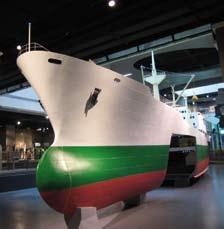

S IGNALS 92 S e PT e MB e R TO NOV e MB e R 2010 43
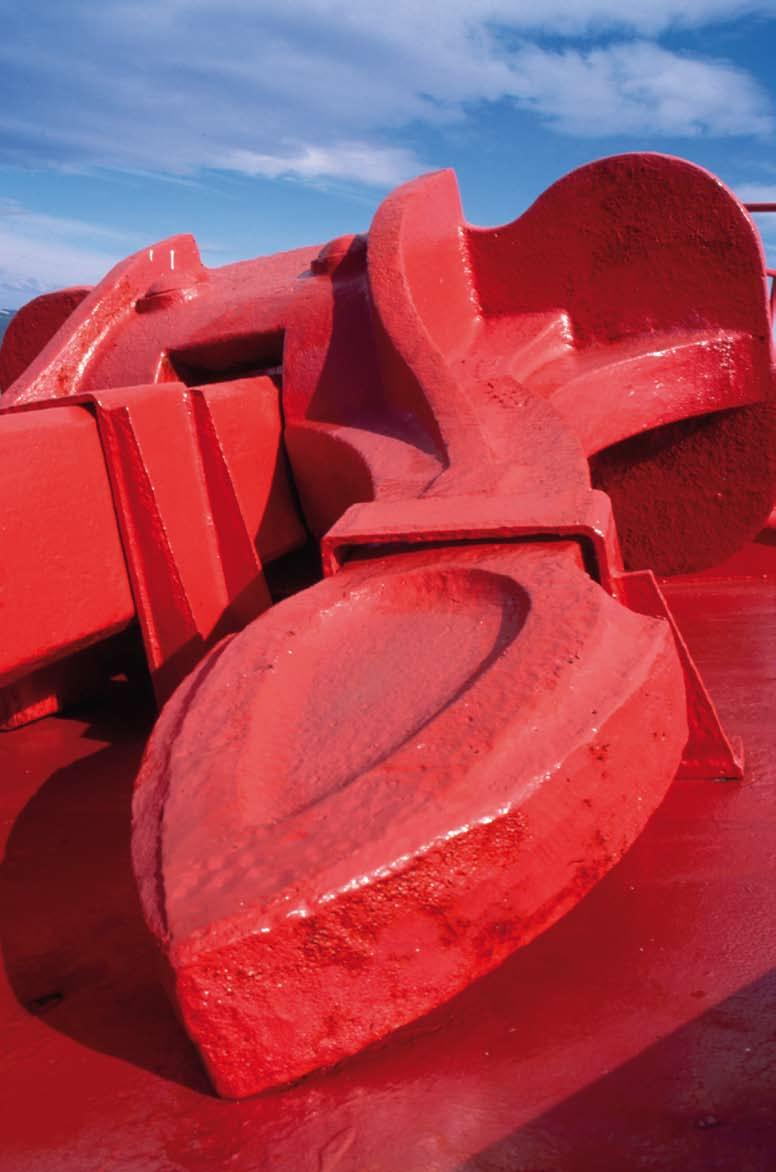
S IGNALS 92 Se PT e MB e R TO N OV e MB e R 2010 44
USA Gallery revisited
The USA Gallery is the enduring legacy of a generous endowment which was the USA’s Bicentennial gift to Australia in 1988. Its purpose is to showcase the longstanding maritime links between the two culturally related nations on either side of the Pacific rim. The gallery’s manager, senior curator Paul Hundley, brings us this update.
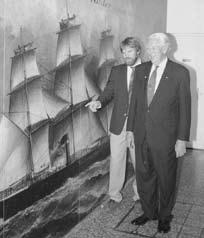
The usa gallery occupies a unique place in the international museum world – it’s essentially the only gallery in a national museum that has been funded by another nation. That’s a reflection of the longstanding and close relations enjoyed by Australia and the United States of America, two English-speaking nations sharing a number of parallels. Both are settler societies that became multicultural, migrant-based nations. Although hemispheres apart and separated by the wide Pacific Ocean, the sea has been a link between them in the areas of maritime exploration, commerce, defence and sport. That’s reflected in the title of the exhibition that premiered when the gallery was opened back in 1991 by US President George Bush senior – Linked by the Sea
Some of the many stories that the USA Gallery has explored have included the role of American whalers in the economic development of the Australian colonies; exchanges of people, culture and technology during the great mid-19thcentury gold rushes; the shifting of strategic alliances; naval battles during the Pacific war of 1941–45; and rivalries in sports such as surfing and yachting.
The founding of the USA Gallery owes a great deal to the personal efforts and vision of the US Ambassador to Australia from 1985 to 1989, the Honourable L W ‘Bill’ Lane Jr AO. Ambassador Lane was instrumental in having the US Congress under President Ronald Reagan vote a US$5 million endowment of the Australian National Maritime Museum, as the US Bicentennial Gift to Australia in 1988 when this country celebrated the anniversary of the founding of the British colony from which our modern nation evolved. Bill Lane’s Order of Australia award was in recognition of these efforts.
In August this year we received the sad news that the former US Ambassador had died in California at the age of 90. This is indeed a loss for the Australian National Maritime Museum. Bill Lane never stopped supporting and encouraging the USA Gallery, and it was always a pleasure to meet him and discuss the gallery’s progress during his return visits to Australia, or our visits to the USA. We extend our sympathy and condolences to all the family and friends who survive him, and devote this update on the USA Gallery to his memory.
Recent
acquisitions
US Exploring Expedition paintings
We recently acquired an attractive series of ink and watercolour paintings executed during the US Exploring Expedition of 1838–42, commanded by US Navy Lt Charles Wilkes, which visited Australia in 1939. The art works were made in August 1839 at Honden Island in the Tuamotu group in what is now French Polynesia. These paintings are highly finished with exquisite detail and inscribed with descriptive notes in pencil.
According to Volume I of Wilkes’ Voyage round the world, embracing the principal events of the narrative of the United States Exploring Expedition (G P Putnam 1851), the four-vessel squadron (US Ships Peacock, Vincennes, Flying Fish and Porpoise) made Honden Island in the Tuamotu Group on 19 August 1839. They found it uninhabited but rich in wildlife. ‘Sharks ... were so ravenous they bit at the oars ... The number of birds on the island was incredible ... The various snakes, the many-coloured fish, the great eels, enormous and voracious sharks, shells, large molluscs, spiders ... all gave a novelty to the scene, that highly
above: Senior curator Paul Hundley and former US Ambassador Bill Lane ao inspect a new exhibition in the USA Gallery in 1994. Photographer Jenni Carter/ANMM
S IGNALS 92 S e PT e MB e R TO NOV e MB e R 2010 45
left: From the exhibition David Moore: Portraits of a shipping company. Photographer David Moore, Hamburg Süd Collection
interested and delighted us. In the afternoon we returned on board, loaded with specimens.’
We presume these paintings were done from those specimens, for eventual inclusion in the reports that would comprise the planned 24 volumes of scientific results of the US Exploring Expedition. The volume on ichthyology was never funded by the US Congress due to the looming Civil War. In addition the manuscript for the publication has been lost; thus these images have never been published.
Hattie E Tapley clipper card
This card, printed in colour with gold highlights, advertises the sailing of the Hattie E Tapley, 946 tons register, Eaton, Master, sailing for Sydney and Brisbane, ‘loading berth, Lewis Wharf, alongside covered sheds, Sept. 2, 1881’. Much as the clipper ships of 1849 sailed to San Francisco to supply the California gold rush, these later clippers carried goods to supply the aftermath of the Australian gold rush. There are many fascinating stories connected with these ships and their voyages.
On Tuesday 14 March 1882, The Maitland Mercury & Hunter River General Advertiser reported: ‘Yesterday morning, about 1 o’clock, William Reed, first mate of the American ship Hattie E Tapley while drinking with a sailor of the same ship, named William Harland, had a quarrel. On going outside the hotel Reed commenced firing his revolver at Harland. He fired five shots, one of which grazed Harland’s head, and another wounded his hand. Constable Ryan rushed up to secure Reed, when he turned on him with a knife with which he struck the policeman in the arm and side, causing the blood to flow copiously. Reed then tried to strike the constable in the region of the heart, but something in the constable’s pockets, most probably the hand-cuffs, prevented the blow from being fatal. Another officer came to Ryan’s assistance, and arrested Reed, who was very drunk at the time. Ryan was not able to appear yesterday at the court.’
Reed was remanded in custody to face the Supreme Court. In April 1882 his case was argued and with the assistance of a clever defence he was found guilty of a lesser charge of unlawful wounding. As a result Reed avoided the sentence of penal servitude for life and was handed down a sentence of imprisonment for two years with hard labour. Whether related or not, in January 1885 an unsavoury
character by the same name, William Reed, was killed by the natives of Slades Island in Papua New Guinea.
Later in its life the Hattie E Tapley came to grief. On 27 November 1889 the barque was wrecked at the Sun Mun Islands, near Hong Kong, during bad weather. At that time the barque was owned by a Mr Finlayson, of Sydney. The following month the Sydney Morning Herald reported that a court of enquiry held in Hong Kong had found that the vessel was not properly manned, seeing that no certificated officer was on board beside the acting master; also that the vessel was not supplied with adequate sailing directions, and the loss of the ship was due to a grave error of judgement on the part of the acting master. However, as the master did all in his power to avert the disaster when he saw the danger, and taking all the circumstances, the court returned the acting master’s certificate.
In March 1890 the Sydney Morning Herald printed the final details of the salvage operations. It reported that the Montlara, with the first cargo of large logs salvaged from the wreck of the Hattie E Tapley, had arrived at Hong Kong in February. ‘The wreck was visited by a party of residents, when it was found that notwithstanding the adverse monsoon upwards of half the cargo had already been recovered and hauled up on the beach, awaiting shipment to Hong Kong, none the worse for its immersion. The salving operations, now the northerly winds have abated, are being vigorously prosecuted with the view of completing the recovery of the entire cargo within the next month. The villagers at the scene of the wreck are most peaceful, and readily give every assistance.’
Ship portrait of the Ocean Chief
The wooden clipper Ocean Chief, 1,026 tons, was built to their own account by J & C Morton at Thomaston, Maine, in 1854. Designed by Samuel Pook, the creator of the famous Red Jacket, Ocean Chief was equally fine and measured 190 feet in length with a 39-foot beam (57.9 x 11.9 metres). Soon after launching, she was sold to James Baines & Co of Liverpool for $85,000 and thereby joined the celebrated Black Ball Line of Australian clippers just when passages to and from that colony were in huge demand due to the prevailing gold rush.
Ocean Chief’s maiden voyage from Liverpool to Hobart set a new record of 72 days for the run, and while her passages home that autumn and the next were 86 and 84 days respectively,
There are many fascinating stories connected with these ships and their voyages to supply the aftermath of the
Australian gold rush
she sped home in 75 days in 1856, the second fastest run of the year. Regularly carrying 109 passengers and a crew of 52, her growing reputation as a flyer proved short-lived when she was destroyed by fire in port at Bluff Harbour, New Zealand, in January 1862.
Recent exhibition
The USA Gallery displays are regularly refreshed, and we take advantage of a temporary exhibition gallery structure in which we can mount exhibitions, drawing upon our own collections or those of other notable institutions. This year we opened a new photographic exhibition, David Moore: Portraits of a shipping company, highlighting a collaboration between David Moore and USA’s Columbus Line that endured for over 20 years.
Australian photographer David Moore grew up in the waterside suburb of Vaucluse in Sydney. At age 11 he took his first photographs of the harbour around him. His childhood experiences and a short period in the Royal Australian Navy gave rise to an enduring fascination with ships, the sea and Sydney Harbour that featured prominently in his work for more than 50 years. Moore also acknowledged the influence of American photographers Walker Evans and Dorothea Lange on his conception of a documentary record through photography.
In 1951 he left Australia for Europe and a career in photojournalism. In 1958 Moore returned to Australia having been on assignments in the USA, Europe and Africa for publications such as Time-Life, Look, New York Times and National Geographic. Moore’s commitment to Australian photography was instrumental in the establishment of the Sydney-based Australian Centre for Photography in 1974.
S IGNALS 92 Se PT e MB e R TO N OV e MB e R 2010 46
clockwise from right: Sailing card advertising the voyage of the Hattie E Tapley, 946 tons register, eaton, Master, for Sydney and Brisbane. Purchased from US Gift fund
The Black Ball clipper Ocean Chief on her Australian run with the crew aloft reefing-down the sails. Ship portrait attributed to Duncan McFarlane (1834–71). Oil on canvas, 63.5 X 101.6 cm. Purchased from US Gift fund
Ink and watercolour paintings executed during the US exploring expedition of 1838–42, commanded by US Navy Lt Charles Wilkes. Purchased from the US Gift fund
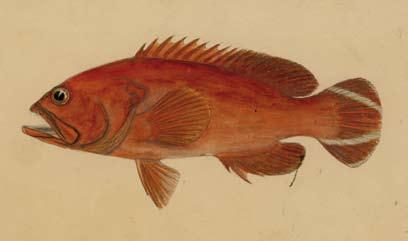
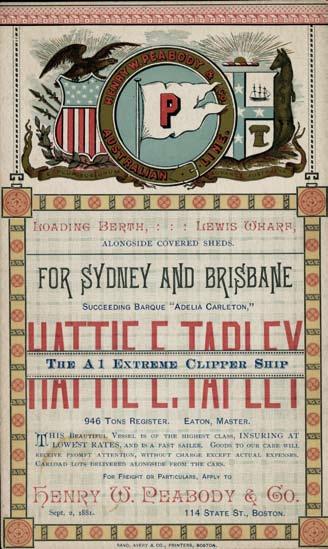

S IGNALS 92 S e PT e MB e R TO NOV e MB e R 2010 47

The USA Gallery is a reflection of the longstanding and close relations enjoyed by Australia and the United States of America
carriers. Columbus Line is now known by the name of its parent company Hamburg Süd.
The collaboration between David Moore and Columbus Line was a success and the relationship endured for over 20 years. During this time the photographer travelled on board many of the ships that made up the growing fleet. He also photographed them extensively from coastal vantage points, surface craft and helicopters. This work ultimately resulted in the creation of a unique archive of images that defines an era of Australia’s commercial maritime history.
Ambassador Bill Lane USA Gallery Fellowship
In 1978 the Columbus Line commissioned a new high-profile advertising campaign that focused on the symbolic appeal of the company’s easy-to-recognise red ships, developed through a strongly pictorial approach to help augment the popularity of its new services. To bring the campaign to life David Moore was asked to capture the grandeur of the vessels at sea, as well as their structural complexity at all scales. The advertising campaign projected a sense of pride and strength of purpose that reflected Columbus Line’s business approach.
Columbus Line introduced containerisation on the trade routes between Australia, New Zealand and North America in 1971, using purposebuilt ships that bore the names of all three nations. By the late 1970s, thecompany had already commenced its ascent as one of the region’s most successful container
The aim of the Australian National Maritime Museum’s USA Gallery Fellowship is to foster professional relationships with key American cultural institutions to develop links between the National Maritime Collection and US collections. The fellowship is open to scholars and museum professionals with a proven record. We welcome proposals that develop greater understanding of the maritime heritage shared between Australia and the United States of America.
The proposed fellowship projects are assessed on their potential to reflect the common development of the two nations and their maritime connections in commerce, culture, immigration, exploration, technology, defence, sport and marine science. The fellowship can be used to develop special public programs relating to the USA Gallery
or the theme of Australia–USA maritime relations including travelling exhibitions, temporary exhibitions, education programs, lectures, seminars and publications. It also provides for the continuing evolution of the USA Gallery reflecting the results of research, further acquisitions and evolving ties between the USA and Australia.
The USA Gallery Fellowship is awarded for periods of up to three months and provides assistance of up to A$30,000 to cover airfares, a stipend and assistance with accommodation costs. During the course of the fellowship the recipient gives a public lecture or conducts a seminar for staff. The fellow also provides the museum with a written report on the outcomes of the project and any further collaboration that is planned.
The fellowship has been funded through the USA Gallery Bicentennial Gift Fund which provides on-going finance for the gallery’s operational expenses, acquisitions, exhibitions and related projects as specified under the terms of agreement between the Commonwealth of Australia, the United States of America and the Australian National Maritime Museum. It is overseen by a Consultative Committee that is co-chaired by the serving United States Consul General in Sydney and the director of this museum.
In recognition of the great support of the late L W ‘Bill’ Lane Jr AO, related in the opening paragraphs of this report, the fellowship will henceforth be known as the Ambassador Bill Lane USA Gallery Fellowship.
Images of Columbus Line container ships from the exhibition David Moore: Portraits of a shipping company, photographer David Moore, Hamburg Süd Collection.
S IGNALS 92 Se PT e MB e R TO N OV e MB e R 2010 48





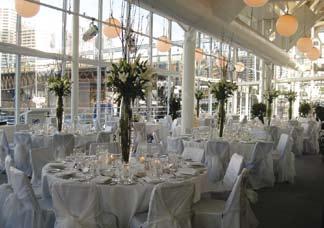
Drinks on destroyer Vampire … dinner for 150 in the elegant Terrace Room ... harbourside Yots Café … or up to 300 in our North Wharf marquee (mid-November to mid-December).
Award-winning Bayleaf Catering is renowned for innovation, quality menus and fine service delivery.

The museum’s unique venues, sweeping city skyline, water views and fine catering will make your wedding day one to remember!
A special place to tie the knot 02 9298 3649 email venues@anmm.gov.au
T he W e l come W all C erem o n y Sunday, 19 September 2010
p r o v id e v i s it ors t o t he We l come Wall u n v e ili n g ceremo n y a w on d erfu l o pp or t un i t y t o sh a re a mea l wit h t he i r fam il y a n d f r i en d s. We are a bl e t o ca t er t o s ma ll or l ar g e f am il y g rou p b ook i n gs an d f a m il y reun i ons i n t he ca f é or t he adj acen t Ter ra c e Room . Open for breakfast
lunch. Bookings essential. Enquire on:
eat@yotsdarlingharbour.com.au S IGNALS 92 S e PT e MB e R TO NOV e MB e R 2010 49
www.anmm.gov.au/venues Dine at Yots
Yots Café Bar, located on the waterfront at the Australian National Maritime Mu s eum, can
and
[02] 9211 5144
Australian Register of Historic Vessels
H istoric
Yachts skiffs punts and luggers
Since the Australian Register of Historic Vessels was launched in February 2007, yachts have been the most frequently nominated category of vessel. Avian is a representative of the well-known Tumlaren class from Victoria, where a fleet of these Scandinavian designs was established in the 1930s. Hinemoa comes from Lake Macquarie builder Ivor ‘Chips’ Gronfors and highlights a design with unusual details for its period, inspired by the Tasmanian one-design class. Vanity is another of these Tasmanian one-designs and joins some of its sister vessels already listed, while Lorita Maria is a famous ocean racing yacht designed by naval architect Alan Payne. This well-known designer shows the breadth of his work with the inclusion of the tender for the Lorita Maria representing a specific design prepared by Payne with the same attention to detail as the yacht it was built for.
A contrasting dinghy is the restored piners’ punt now called simply Punt These craft were common in the southwest of Tasmania where they were used by the loggers to access remote areas to cut the now rare, precious timber Huon pine. The slow-growing species was valued for its extreme resistance to rot, prized for applications as diverse as underground mine shoring timbers to boat and yacht building. The piners’ punt was built of King Billy pine, another durable, easily worked Tasmanian timber. The equally well-known Queensland red cedar wood was used to plank
The Australian Register of Historic Vessels (ARHV) was increased by 25 craft when the ARHV Council met in June this year. This issue of Signals features half of the new entries; the next issue will feature the remainder. As always it is a diverse collection of craft, says the curator of the ARHV
David Payne.
another open boat now listed in ARHV, the clinker skiff for philanthropist and keen oarswoman Dame Eadith Walker in 1895.
Four pearling luggers are listed. These are a type specific to Australia and the ARHV is working towards listing the few remaining luggers as quickly as possible, to assess the full range of the surviving examples. Tribal Warrior from 1899 is widely believed to be the oldest lugger extant, and comes from the Japanese builder Tsugitaro Furuta, who also built Penguin in 1907. He was based on Thursday Island and these craft are typical examples for their respective periods of the deeper-keeled type that worked that area. Meanwhile, luggers Trixen and Intombi have the characteristics of the shallower Broome type. Both were substantially rebuilt into new and bigger craft, a common occurrence brought about when pearling lugger owners sought to avoid fees for registering a new craft by pretending to repair an existing lugger. The four pearling vessels also show the diversity of roles that surviving luggers now undertake. Two are on display as museum vessels: Penguin is a feature of the Queensland Maritime Museum, while Trixen was extensively researched and restored by Bill Leonard at the West Australian Maritime Museum where it is suspended in their main building at Fremantle. By contrast, Intombi is a popular charter vessel at Broome, the last of the early fleet of Broome
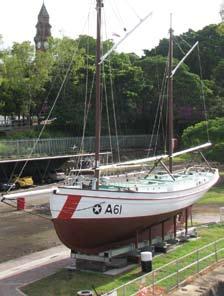
luggers still working in the region. And Tribal Warrior has become a feature on Sydney Harbour as the flagship for the Tribal Warrior Association, flying the Koori flag for the well-known Indigenous community support group. (The Tribal Warrior Association and its historic lugger were featured in Signals No 90 March 2010.)
Another distinctive Australian vessel type that the ARHV is also focusing on, in order to list and compare all of the remaining craft, is the 21-Foot Restricted Class. This famous class was the backbone of intense interstate rivalry from the 1920s until the mid-1950s. This class raced for The Forster Cup each year, and new designs appeared up until the late 1940s. Nautilus from 1946 represents the final period of development of what was probably Australia’s first design rule for a yacht class that was developed entirely in this country. It grew from the working boats in and around Port Phillip, and shared structural features that are also seen on the famous ’couta fishing boats. ARHV research is showing that Jesamine is possibly the earliest 21-Foot intact, and still sailing as well. It has the distinction of having been converted to a fishing boat after a short period as a 21 by its wellknown builder and owner Mitch Lacco, one of the principal ’couta boat builders of the region. These days Jesamine is restored as a 21 and is able to race in the 21-Foot Restricted Class, or as a ’couta boat if it chooses to do so, a rare distinction.
S IGNALS 92 Se PT e MB e R TO N OV e MB e R 2010 50
www.anmm.gov.au/arhv This online, national heritage project devised and coordinated by the Australian National Maritime Museum reaches across Australia to collate data about the nation’s extant historic vessels, their designers, builders and their stories.
opposite: The 1907 pearling lugger Penguin is one of two vessels accepted into the register this year that were built on Thursday Island for the Torres Strait pearling industry by the Japanese shipwright Tsugitaro Furuta. It’s shown here displayed at the Queensland Maritime Museum.
Lorita Maria's tender
Builder Jeff Clist
Type Yacht dinghy
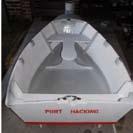
Builder J J Savage
Type Tumlaren class racing yacht
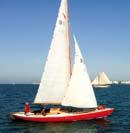
Builder J J Savage
Builder Harry Ward
Type Rowing skiff

Type 21-Foot Restricted Class racing yacht Penguin
Builder Tsugitaro Furuta
Type Pearling lugger


Builder Ivor ‘Chips’ Gronfors
Type Cruising and racing yacht
Intombi
Builder Chamberlain and Cooper
Type Pearling lugger
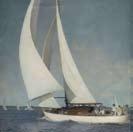

Builder Mitch Lacco
Type 21-Foot Restricted Class

Builder unknown
Type Huon piner’s dinghy
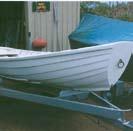
Builder Tsugitaro Furuta
Type Pearling lugger Trixen
Builder unknown
Type Pearling lugger
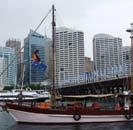
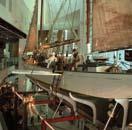
Builder Jeff Clist
Type Racing yacht

Builder
Lucas Type

All
photographs are reproduced courtesy of the vessel owner.
Avian 1938 HV000385
Dame Eadith Walker 's rowing skiff
1895 HV000411
Hinemoa
1938 HV000407
1930
HV000405
Jesamine 1921–22 HV000400
racing yacht, later a fishing boat
1963 HV000392
Lorita Maria
1963
HV000397
1946
Nautilus
HV000387
1907
HV000396
1920s
Punt
HV000404
1899 HV000408
Tribal Warrior
1904 HV000391
Vanity 1911 HV000388
Charles
Racing
S IGNALS 92 S e PT e MB e R TO NOV e MB e R 2010 51
yacht
Welcome

We were a whole world apart
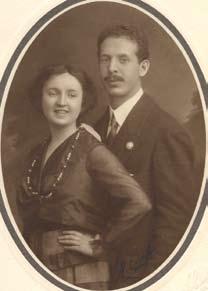
Racist hatred tears apart a european family, but human goodness protects its children until they’re reunited with their parents in Australia years later, as young adults. Welcome Wall coordinator Veronica Kooyman relates their moving tale.
When the Nazis annexed Austria in 1938, many Jewish Austrians fled their homeland in fear of a bleak future, leaving behind businesses and possessions, friends and even family. For Robert and Ernestine Weber, it meant separation from their children Hans and Suse for nine years before reuniting on the other side of the world. Yet they were among the lucky ones.
Robert Weber was an Austrian Army veteran of the Russian Front in World War I. He lived in the heart of Vienna selling new and second-hand books, antiquarian books, opera libretti and schoolbooks. His wife, Ernestine, ran the business’s lending-library and they lived near their shop with their two young children, Hans and Suse.
Ernestine’s heritage was Eastern European. She was the third child and only daughter of Mordechai Kempler from the border region between Poland and Russia; her mother Josephine was of Hungarian ancestry. Robert Weber was born in rural Austria, the third of four children from a relatively poor family of tailors. They moved to Vienna when Robert was 10, and by 14 he was apprenticed to the bookseller who later made him a partner in the business. He married Ernestine in 1912 and their children were born in 1923 and 1927.
irrevocably changed with the German declaration of Anschluss (unification). German troops occupied the country to enforce it and Austrian Nazis were installed to run the government. Austria ceased to exist as an independent state and was subsumed into the Third Reich.
above: ernestine Kempler and Robert Weber’s wedding portrait, Austria 1912. All photographs reproduced courtesy of Suse Mathes and family. opposite clockwise from top right: P&O Strathaird carried Robert and ernestine from Ceylon on the last leg of their voyage to Australia.
The Weber family, Hans, Robert, ernestine and Suse, together briefly in england in 1939. They would not be reunited until 1947.
Hans and Suse Weber as children in Austria, with their Aunt Helen.
Despite the difficulties and sacrifices of building up a business, life for the young family in Vienna was good. Family memories include sunny Sunday afternoon outings to one of the many beautiful gardens on the edge of the city, and readings to the young children from the wonderful stories that could be found in the family’s bookshop.
This happy family could scarcely guess what was to come to all of Europe as Hitler gathered his armies and began the move towards war. In early 1938 the lives of the Jewish population of Austria
Segregation in schools began, money and possessions were confiscated and some Jewish families were forced into shared living spaces, forerunners of the ghettos that were to follow in various occupied countries in 1940. The Weber family was allowed to continue running their antiquarian business for a short time due to Robert’s status as a war veteran, overseen by a government commissioner who fleeced most of the profits. Then, with no notice, Ernestine and the children were moved to an unknown Jewish woman’s apartment a few streets away, and were instructed they were no longer allowed to go outdoors. Robert found them several hours later. Fear was spreading and the family knew they had to leave Austria. With so many of Europe’s Jewish population urgently trying to leave their homelands, passports and visas were extremely difficult to obtain and queues for emigration to countries such as the United States were very long. Robert applied to both Brazil and Australia. While waiting for a response, the instinct to protect the children led the Webers to search for a quicker way to evacuate their children.
A former business customer had already reached England and located a family willing to take Hans.
In December 1938 Hans left first for England to live with the Venables family in Stafford. The Jennings family, close relatives of the Venables, offered Suse a home and she travelled with the Kindertransport program that evacuated thousands of Jewish children from Germany, Austria and Poland to the
Tales from the wall
S IGNALS 92 Se PT e MB e R TO N OV e MB e R 2010 52
The museum’s tribute to migrants, The Welcome Wall, encourages people to recall and record their stories of coming to live in Australia
This happy family could scarcely guess what was to come to all of Europe as Hitler began the move towards war

United Kingdom. She left in March 1939 for the Netherlands to join a ferry in the Hoek van Holland, and sailed at midnight for Harwich, England. Both children were lucky to have sponsors waiting for them on a railway platform in London, unlike the vast majority of children fleeing on the same trains with foster homes not yet confirmed.
When parents Robert and Ernestine were granted Australian visas they stealthily left Austria, taking different routes to Paris. There they met on a railway platform and travelled to England to see their children.
Reassured by the two kind English families that their children would be cared for, they boarded the Rotterdam Lloyd Royal Dutch Mail vessel MS Balorean at Southampton on 12 May 1939 and sailed for Colombo, Ceylon. Here the couple transferred to the P&O liner RMS Strathaird and disembarked in Melbourne on 13 June 1939.
In Australia the couple went about rebuilding their lives, buying a milk bar and later running a bakery now known as the Monarch Cake Shop in Acland Street, St Kilda, next to the Scheherazade restaurant. The business is still an icon in Melbourne though the Weber family


sold the business in 1949. Robert and two colleagues went on to establish the Neue Welt, a German-language newspaper, until he retired in 1964 at the age of 80. Throughout World War II and beyond, the children were separated from their parents on opposite sides of the globe. With the help of the Jewish Refugee Society, Hans and Suse arrived on the Johan de Witt, a Dutch steamer that completed a single trip to Australia, bringing nearly 1,000 Jewish refugees from postwar Europe and arriving in March 1947. According to newspaper, reports, one of the refugees alleged that a fellow passenger was a German implicated in the war. The suspect was declared a prohibited immigrant and returned to Germany amid a political stir about the screening process for refugees. By the time Hans and Suse had reached Australia they were in their early twenties after spending their formative years in a foreign country with a foreign family. War had robbed them and their parents of the chance to share their development as children and teenagers. Yet their survival had been due to the kindness of their foster families, forging a deep bond through an unimaginable experience.
The families in England and Australia never lost contact, though Robert and Ernestine have now passed on.
Hans and Suse settled into yet another new life, here in Australia. Hans began work with the Herald Sun in Flinders Street and remained there for 40 years. He never married. Suse finished her nursing training here, marrying and having a family. She has not left Australia since she arrived over 60 years ago. In 2010 she has three daughters and three grandchildren. Suse has registered her parents Robert and Ernestine on the Welcome Wall, while her daughter Kathie registered Suse and Hans. Their names were unveiled at our latest ceremony in May this year.
The Welcome Wall
It costs just $105 to register a name and honour your family’s arrival in this great country! We’d love to add your family’s name to The Welcome Wall, cast in bronze, and place your story on the online database at www.anmm.gov.au/ww. So please don’t hesitate to call our staff during business hours with any enquiries on 02 9298 3667.
S IGNALS 92 S e PT e MB e R TO NOV e MB e R 2010 53
Sydney Transport Montage Reginald Fizelle
This striking modernist view of Sydney’s harbour, industry and transport was part of a donation of maritime art from the corporate collection of the waterways authority, NSW Maritime. Curator of environment, industry and shipping, Dr Stephen Gapps, introduces the artwork and its artist.
dedicated to ensuring the safe and environmentally responsible use of state waters.
Reginald Cecil Grahame Fizelle – known as 'Rah' to his associates –was born at Baw Baw, near Goulburn, New South Wales. He began training as a school teacher in Sydney until he enlisted in the Australian Imperial Force in January 1916. Fizelle returned to Australia after World War I suffering from the effects of a poison gas attack. He concentrated on teaching art and in 1921 won a scholarship to Julian Ashton’s Sydney Art School. During the 1920s he chiefly painted landscapes in watercolours and exhibited with the Society of Artists and the Australian Watercolour Institute.
the Sydney semi-abstract movement, showing work by Balson, Crowley, Fizelle, Frank Medworth, Gerald Lewers and others. In the 1940s and early 1950s Balson’s and Crowley’s body of abstract ‘constructive paintings’ were unique in Australia.
Considering recent public debates about Sydney’s seemingly over-extended transport system and infrastructure, this recent acquisition by the Australian National Maritime Museum presents a timely opportunity to reflect on some earlier visions of the harbour city and the transport modes, waterborne and otherwise, that service it. The painting Sydney Transport Montage, made in about 1948 by Reginald Cecil Grahame Fizelle (1891–1964), is a large, eclectic montage of transport and industry that provides a rare Australian modernist view of Sydney Harbour just after World War II. It’s an ambitious work that presents an intriguing vision of Australian society at the time.
The painting was part of a selection of maritime art generously donated to the museum by the state government authority now known as NSW Maritime (formerly the Maritime Services Board), a self-funding regulatory authority
In 1927 Fizelle moved to Europe and studied at the London Polytechnic School of Art and the Westminster School of Art under the accomplished modernist and figurative artist Bernard Meninsky. During this time Fizelle’s landscape paintings and watercolours became simplified, stylised and geometric. Back in Sydney, between 1932–37, Fizelle teamed up with Grace Crowley to establish a studio. Crowley had studied at André Lhote's academy in Paris and was particularly interested in Lhote's academic cubism. Crowley was the most experienced – and many now argue one of the greatest – modernist painters in Australia.
The two artists established the Crowley-Fizelle school and conducted joint classes. Their studio at 215a George Street, Sydney, was the principal centre for modernist painting and the most advanced centre of modern art in Australia at the time. It was here that Ralph Balson and others explored geometric, cubist principles of composition.
In 1939 the group held a long-planned manifesto exhibition, 'Exhibition 1', at the David Jones Art Gallery. The exhibition was a climax for
The painting Sydney Transport Montage is an ambitious grouping of imagery. It centres on Circular Quay, with the arch of the Sydney Harbour Bridge spanning a harbour ferry heading towards the Maritime Services Board building (belatedly completed in 1948, and now the Museum of Contemporary Art). Yet it jumbles together other Sydney sites including the grain silos of Glebe Island and the clock towers of the Lands Department and Central Railway buildings.
The painting also moves through time, with a paddle steamship and a sailing vessel from the past sharing the scene with a futuristic steam train powering through the centre of the composition. All this activity and motion is backgrounded by an empty depiction of Australia, its featurelessness contrasting with the busy industrial development of the city on the rim of the continent.
Is this a modernist celebration of postwar Australian industry and technology, or is the crowded and confused montage a commentary on modern Sydney? Considering that Fizelle’s later work was very much concerned with natural themes and subjects, the latter appears likely.
Fizelle’s Sydney Transport Montage – while not one of the most outstanding works by Sydney modernists – certainly highlights their central tenet of the rejection of traditional representational styles. It is also important as a work that grapples with the intense development of postwar Sydney at a time when most Australians were enamoured of ever newer and faster modes of transport – so much so that not too long after this was painted, Sydney would dismantle
Collections
S IGNALS 92 Se PT e MB e R TO N OV e MB e R 2010 54
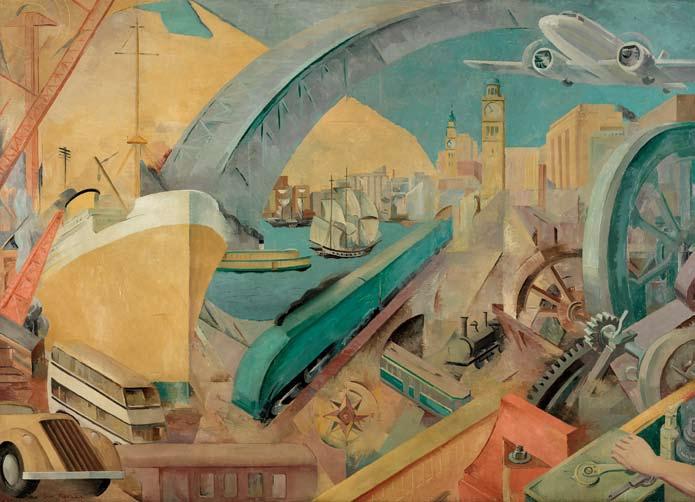
its efficient, and now frequently lamented, tram network to clear the roads for buses and private cars.
The painting is one of Fizelle’s last efforts to master the modernist techniques. From the 1950s onwards, he turned to near-abstract figures in carved wood, sandstone and pottery, as well as more realistic watercolours of natural abstract structures such as eroded rocks or tree forms.
After Fizelle died in 1964, a major exhibition of the work of Fizelle, Balson, Crowley, and Hinder was held by the Art Gallery of New South Wales in 1966 and again in a retrospective of Sydney modernists in 1984.
Whilst Fizelle is regarded as one of the founders of the so-called George Street Group and a leading Sydney modernist, he has also been described as one who was not completely able to master modernist techniques of section and symmetry. Still, this abstract work with
its elements of cubism and constructivism reveals a view of Sydney Harbour –and Australian society – from the perspective of a modernist artist, and as such it is a remarkable acquisition.
Sydney Transport Montage was part of a corporate collection assembled by NSW Maritime. The other works offered to this museum by the regulator of NSW waters include paintings by contemporary maritime artist John Steven Dews (Australia Day 1988 – The Bicentennial First Fleet Arriving in Botany Bay and Australia Day 1988 – Tall ships in Sydney Harbour); two works by Geoffrey Odgers (Shadow Painting No. 60 and Boats 1988), and three ship portraits by wellknown maritime artist John Allcot (1888–1973) of the coastal steamers Benandra and Bodalla, and the NSW Government Vice-Regal steam launch Lady Hopetoun The portrait of Lady Hopetoun was published in the last edition of Signals (No 91 June 2010, page 39).
This recent acquisition is a timely opportunity to reflect on some earlier visions of the harbour city and the transport modes, waterborne and otherwise, that service it.
Sydney Transport Montage, 1948, by Reginald Cecil Grahame Fizelle (1891–1964), 2000 x 2650 mm, oil painting on board. ANMM Collection. Photographer A Frolows/ANMM
S IGNALS 92 S e PT e MB e R TO NOV e MB e R 2010 55
Readings
Praise the Lord and pass the ammunition
Pirate outrages – true stories of terror on the China Seas compiled by Douglas Sellick, publisher Fremantle Press 2010. Paperback, 368 pp. ISBN 978 19 21669 607 7. RRP $26.95
Piracy! Of all the great narratives of maritime history – discovery, trade, migration, shipwreck, warfare – piracy occupies an extraordinary place in our collective consciousness. It summons vivid memories of childhood storybooks, swashbuckling film stars and fierce, larger-than-life characters to provide us with ready-made images and imaginings about this topic.
The reality, of course, was – and still is – something quite different. Piracy, possibly as old as seafaring itself, has many contexts. Sometimes it was simply opportunist plunder, away from the oversight of authority. Other times it’s been part of a wider anarchy, when authority has broken down altogether. On occasion it’s been a response to a dire lack of economic alternatives. Or both, if we think of today’s audacious Somali pirates attacking huge cargo ships from their outboard-powered pirogues.
At other times piracy has been statesanctioned aggression against rival states, with privateers doing the work normally associated with navies. And there have been ample times and places when seaborne rebels or resistance fighters have been branded as pirates by those invading them, and dealt with accordingly.
There’s something of all of these contexts in the piracy recounted by this gripping collection of historical accounts, set mostly on the coast of China from the early 1800s to the 1920s. This, of course, was the period of declining Imperial Chinese power in the face of the West’s unstoppable, seaborne mercantilism, when Britain joined with the other naval and industrial powers of Europe and America to force their way into Chinese ports and markets, quelling resistance with the Opium Wars and enforcing their own terms of trade.
Look at the book’s map of the waters around Canton, Hong Kong and Macau and the coasts to the north and south,

where most of these accounts take place and you’ll see what a pirates’ paradise they are – indented and strewn with channels, islands and reefs. On this rugged coast with its hundreds of hideaways it’s impossible to tell which of the myriad fishing or trading junks is a pirate – until they’ve hurled their grappling irons and pyrotechnics and are swarming on board with spears and swords and crude firearms!
The breakdown of Chinese authority in the face of Western intrusion was a factor in the lawlessness of these coasts, and much of the piracy depicted here was a seaborne variant of the old protection racket: ‘Pay up or we’ll plunder and pillage’. Most of the victims are Chinese, and we don’t hear from them first-hand since they are illiterate fishermen or villagers. The voices we do hear are all Western ones, raised in indignation when this plague of piracy spills over and threatens Western interests, shipping, cargoes and lives.
The compiler, prolific Douglas Sellick, has had evident fun hunting down these accounts from a huge variety of sources including the Australian National Maritime Museum’s Vaughan Evans Library. In this collection you’ll hear from admirals and administrators, merchants, customs men and sea captains as they thunder and fume against the pirates.
This was a seaborne variant of the old protection racket: ‘Pay up or we’ll plunder and pillage’
You’ll even meet a young Anglican bishop who joins the famous white rajah, James Brooke, to hunt down the Ilanun (SeaDayak) pirates of Borneo, in the book’s only excursion away from the China coast. Enjoying the advantages of steam power and artillery, our bloodthirsty bishop praises the Lord and his doublebarrelled Terry’s breechloader!
More revealing are the voices of hapless Westerners who have survived capture and ransom by the pirates –including the delicate Frenchwoman Fanny Loviot – since they take us closest to the lives of the outlaws. So too the early-20th-century journalist who meets the extraordinary ‘queen of the Macao pirates’ on the decks of her own junk. It’s not quite ethnography – colonial-era prejudices are too ingrained for that – but it allows a glimpse of the renegades as human beings of a sort. It’s a welcome counterpoint to the prevailing brutality of the times, dished out by the lawless and law enforcers alike.
A century on from the period covered by this collection – a period that was one of the low points in the power and prestige of the world’s oldest civilisation – few will read this collection without reflecting on the very different relations between a re-emergent China and the West today. Some might reflect upon how much Western attitudes and assumptions in that earlier period – conveyed throughout these pages – have influenced today’s China and its view of the West.
Thankfully piracy is nowhere near as rampant today – although not all makers of luxury goods, music, films and computer programs would agree!
Mary-Louise Williams, Director
S IGNALS 92 Se PT e MB e R TO N OV e MB e R 2010 56
Kurnell artists inspired by Endeavour

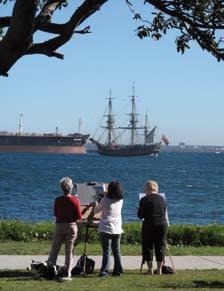
An exhibition at The Art Gallery on Prince Charles Parade at Kurnell, on the south-eastern shore of Botany Bay, celebrates the visit of the museum’s replica of James Cook’s HM Bark Endeavour in April this year on the 240th anniversary of the real ship’s historic visit here in 1770. It showcases the work of the Kurnell Artists Cooperative, whose members gathered with their easels, pencils, paint and brushes to work from life as the ship anchored on the bay on 29 April, the anniversary day. The exhibition is called Bound for Botany Bay, inspired by these local artists’ love of the water, Australia’s coastal life style and the visit of the Endeavour replica in April to celebrate the most important event in the history of the locality – indeed, the foundation event in the history of Australia’s settlement by Britain.
The Kurnell Artists Cooperative comprises residents of the Botany Bay-side location where James Cook stepped ashore in 1770, with some members living further afield in Sutherland Shire. The group was started in 2008, says its founding member Monica Hoban, when a new beach-front café – named Endeavour, not surprisingly – opened for business next door, presenting an opportunity for a gallery to take advantage of the café trade. The cooperative, usually numbering
10 artists, opens the gallery on weekends and public holidays from 10 am to 4 pm. It also opens by appointment. The gallery has regular Indigenous contributors, and their youngest Endeavour portraitist is just 13 years old.
It’s not too surprising, either, that the Endeavour replica’s visit last April should have inspired the group – especially considering that one of their more recent members, Deborah Mattson, is married to its master, the Australian National Maritime Museum’s Captain Ross Mattson. The couple have lived for 18 years in Kurnell – well before Ross’s association with the replica of the ship that anchored here 240 years ago – where they are raising their two children.
‘As an artist living on the shores of Botany Bay and the wife of a sailor I can’t help but be inspired by our beach culture and maritime industry,’ says Deborah, whose mother is also a successful artist.
‘It has become a normal part of my life to wait for the ship to come home, when Ross and the Endeavour are voyaging. There is something creative about waiting. My imagination runs away while I watch the waves move and the sun sparkle off the water’s surface. My inspiration is about what’s happening during the voyages, rather than the ship itself. What are the sailors seeing? What’s under the water where the ship’s
right: Some of the members of Kurnell Artists Cooperative who gathered on 29 April to record the visit of the Endeavour replica on the 240th anniversary of Cook’s visit in 1770.
sailing? Will the weather be kind or will they suffer from a raging sea?’
Kurnell is a fascinating part of Sydney, with its unusual mix of housing, industry, beaches and national park that are just a short line-of-sight from Sydney’s CBD, while enjoying a certain remoteness due to its geography at the end of a road that takes a long sweep around Botany Bay’s southern shoreline. The Captain Cook Landing Place interpretation centre displays one of James Cook’s four-pounder cannon that were tossed overboard to lighten the original Endeavour when it hit a reef near Cooktown and was nearly lost in 1770. The cannon were salvaged and conserved in the 1970s. JM
The exhibition Bound for Botany Bay is a work in progress– some of the Endeavour portraits sold right off the easel back in April – but most will be on display during September, October and November, 10.00 am to 4.00 pm weekends and public holidays.
left: Members of the Kurnell Artists Cooperative at The Art Gallery, Kurnell. Left to right: Ray Tickle, Janette Regby-Sammutt, Monica Hoban, Noel Carigg, and Deborah Mattson at far right. Photography J Mellefont/ANMM
Currents
S IGNALS 92 S e PT e MB e R TO NOV e MB e R 2010 57
Museum welcomes the plastic bottle yacht
Plastiki, the remarkable ocean-going yacht made from 12,500 reclaimed plastic bottles, was on view at the Australian National Maritime Museum’s new Display Pontoon for a month after its arrival in Sydney on 26 July. The 18-metre catamaran had just concluded an epic 8000 nautical mile voyage from San Francisco, California, as part of a campaign to reduce the vast quantities of man-made waste, notably plastic bottles and plastic bags, that constantly find their way into landfill and the ocean.
The leader of the expedition was David de Rothschild, a descendent of the famous British banking family. He and its British skipper Jo Royle and the Plastiki crew, and its Australian designer naval architect Andy Dovell, were welcomed to the museum in a well-attended public ceremony by the Deputy Lord Mayor of Sydney, the US Ambassador to Australia and the founder of Clean Up The World.
The Sunday following the arrival the museum hosted an open day, allowing the public to meet with David de Rothschild and other crew members and learn more about their ecological voyage and the remarkable vessel. The Plastiki has taken advantage of all available sustainable design technologies and cutting edge materials. A unique recyclable plastic material made from srPET makes up her super structure. The mast is a reclaimed aluminum irrigation pipe, and the one-ofa-kind sail is hand-made from recycled PET cloth. The secondary bonding is reinforced using a newly developed organic glue made from cashew nuts and sugar cane. The vessel carried renewable energy systems including solar panels, wind and trailing propeller turbines, bicycle generators, a urine to water recovery and rain water catchment system, and a hydroponic rotating cylinder garden.

The museum’s director Mary-Louise Williams congratulated the Plastiki crew on their extraordinary and challanging voyage. She said the museum was pleased to be able to put notable vessels like Plastiki on display for everyone to see. ‘Museums are not only interested in the past,’ she said. ‘We’re interested in what’s happening today as well. History is being made around us, all the time. What’s more, the museum is committed to the concept of clean and healthy oceans.’
clockwise from left: Plastiki arrives at the museum. Speakers at the welcoming ceremony: Deputy Lord Mayor of Sydney Mr Phillip Black; the US Ambassador to Australia, Mr Jeff Bleich; the founder of Clean Up the World, solo yachtsman Mr Ian Kiernan ao; and Australian National Maritime Museum director Mary-Louise Williams. On the open day Angus Green, 6, showed his model boat made of recycled materials to expedition leader David de Rothschild centre) and Clean Up The World founder Ian Kiernan. Photographs: J Mellefont/ANMM; Clean Up the world
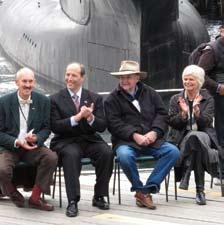

Currents
S IGNALS 92 Se PT e MB e R TO N OV e MB e R 2010 58
Historic circumnavigator turns 100, gains OAM
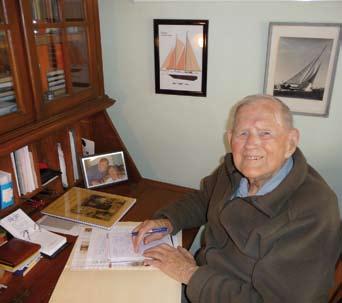
June 2010 was a noteworthy month for Richard ‘Dick’ Nossiter, who in 1935–37 was navigator on the first Australian yacht to circumnavigate the globe. The week before he turned 100, he received the Medal of The Order of Australia (OAM) in the general division for his part in the circumnavigation, announced in the Queens Birthday 2010 Honours List. He then turned 100 on 22 June.
In 1935, at the age of 25, Dick embarked with his father Harold Nossiter Snr and his brother Harold Jnr on the

family’s 53.5-foot, 35-ton staysail schooner Sirius, on which they sailed from Sydney via Bali, Malaysia, Colombo, Suez and the Mediterranean to reach England in June 1936. They returned via Madeira, Trinidad, Panama, the Galapagos, French Polynesia, the Cook Islands and Tonga, reaching Sydney in May 1937. Harold Snr’s two volume voyage account, Northward Ho! and Southward Ho!, became a classic. In 1989 Dick’s brother Harold donated 700 nitrate negatives to this museum, recording the voyage and other family sailing ventures betwen 1922
and 1941. An account of the world cruise appeared in Signals No 71 June 2005. Dick won the Distinguished Service Cross during his naval service in command of corvettes during World War II, navigated in six Sydney–Hobart yacht races, is the longest-serving member of the Royal Sydney Yacht Squadron and was married for 67 years to Nancy, whom he survives.
Museum sponsors Corporate Members
Foundation
Lloyd’s
SBS
Project
Coral
Defence
Louis Vuitton
Novotel Rockford
Silentworld
The
Alcatel
Ansett Airfreight
Bovis
BP
Bruce
Doyle’s
Howard
James Hardie
National
PG,
P&O
Telstra
Wallenius Wilhelmsen Logistics
Westpac Banking Corporation
Zim Shipping Australasia
Captain Memberships
Art
Asiaworld
Australia
Defence
HMAS Kuttabul
HMAS
Maritime
Maruschka Loupis & Associates
Penrith Returned Services League
Regimental Trust Fund, Victoria Barracks
Royal Caribbean & Celebrity Cruises
Svitzer Australasia
Sydney Pilot Service Pty Ltd
Currents
ANZ
sponsors Blackmores
Channel
sponsor
Major
Ltd
Nine
Register Asia
Raytheon Australia Pty Ltd
Tenix
Pty Ltd
APN
sponsors Akzo Nobel
Outdoor
Sea Wines
Maritime Services Pty Ltd
Foundation Sydney by Sail
Founding patrons
Australia
Limited
ANL
Lend Lease
Australia
& Joy Reid Foundation
Seafood Restaurant
Smith Limited
Industries
Australia Bank
TG & MG Kailis
Nedlloyd Ltd
Admiral three-year membership $10,000 one-year membership $4,000 Commodore three-year membership $5,000 one-year membership $1,850 Captain three-year membership $1,800 one-year membership $700
program provides corporate Members privileged entry to the museum’s unique environment for corporate hospitality. Three membership levels each provide a range of benfits and services:
Ltd
exhibitions Australia
Ltd
Shipping Services Pty
Japan Cable Ltd
National Storage-RPA
HMAS Creswell
Newcastle HMAS Vampire Association
Workers Credit Union
Dick Nossiter at his desk in June 2010; leaving Sydney on Sirius in July 1935. Photographs courtesy Tim Nossiter
S IGNALS 92 S e PT e MB e R TO NOV e MB e R 2010 59
Bearings from the director, Mary-Louise Williams

We warmly welcome a new chairman of the Australian National Maritime Museum Council, Mr Peter Dexter am The appointment was announced by The Hon Peter Garrett am mp, Minister for Environment Protection, Heritage and the Arts, just before the Federal election was called. Our new chair brings great experience across the maritime sector that will benefit the work of our council in guiding the museum’s strategic directions and core policies. Peter Dexter is currently chairman of Wilh. Wilhelmsen Investments Pty Ltd and SeaSwift Pty Ltd, and is non-executive director of POAGs Pty Ltd and Wilhelmsen Ships Service Pty Ltd. Previously he was regional director of Wallenius Wilhelmsen Logistics and currently serves the company as its Oceania chairman.
Of equal importance is his long association and familiarity with the museum and its activities. His support has included donating shipping-related material to the collection, and he has served for several years on the Australian National Maritime Museum Foundation which was developed to encourage support for the museum. Mr Dexter’s current role as Honorary Consul-General
of Norway in New South Wales gives him a special link with one of our most important collection vessels, the ketch Kathleen Gillett that was a veteran of the first Sydney–Hobart yacht race. Built to a famously seaworthy Norwegian design, this Australian yacht was restored for us by the Norwegian Government as a bicentennial gift to Australia in 1988. At the same time we farewell outgoing chair of council, Mr Peter Sinclair am csc, a former submariner who commissioned the first of the Collins class submarines for the Royal Australian Navy, and who was chairman since 2007. We would like to extend our sincere appreciation to Mr Sinclair for his service over the last three years and recognise his important contribution to our work.
The end of the financial year came with the good news that the Australian National Maritime Museum has posted its all-time record visitor attendance, breaking the half-million barrier and welcoming 503,778 visitors for 2009–10. Among other things, that tells us that we have long since dispelled the notion that a maritime museum is a niche attraction. It’s a measure of our success in
In July we launched the Endeavour replica’s historic 2011–12 circumnavigation of Australia (see story page 22). With us at the launching were (left to right) the replica’s Captain Ross Mattson; Dr Michael Sharpe ao, former chairman of the HM Bark endeavour Foundation; Mr Bruce Stannard am, member of the museum’s founding council and an initiator of the Endeavour replica project; ANMM director Mary-Louise Williams; and the Minister for environment Protection, Heritage and the Arts, The Hon Peter Garrett am mp Photographer A Frolows/ANMM
interpreting maritime history in a way that increases our understanding of our island-continent nation’s development and identity. It’s everyone’s story.
It's my sad duty to farewell another staunch old friend of the museum, the Honorable L W ‘Bill’ Lane Jr ao, the US Ambassador to Australia from 1985 to 1989, who has died in California at the age of 90. It was Bill’s personal efforts and vision that secured the United States’ Bicentenary Gift of US$5 million in 1988 to fund a permanent gallery in our museum commemorating the many maritime links between our two countries – in the areas of maritime exploration, commerce, defence and sport – that the USA Gallery and collection have explored ever since. His Order of Australia award was in recognition of these efforts. And Bill Lane never stopped supporting and encouraging us. It was always a pleasure to meet him and discuss the gallery’s progress. There’s an update on the USA Gallery starting on page 42. It makes mention of an important research initiative, the USA Gallery Fellowship. We will be renaming that fellowship in honour of our old friend Bill Lane ao
S IGNALS 92 Se PT e MB e R TO N OV e MB e R 2010 60
Hundreds of books something for everyone from key rings to ship models and boating clothes friendly service mail order Members discounts!
Open 9.30 am to 5 pm seven days a week
Phone 02 9298 3698 or fax orders to 02 9298 3675 or email mlee@anmm.gov.au
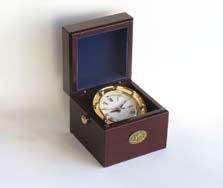
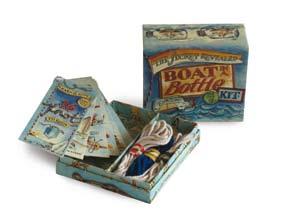


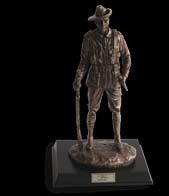
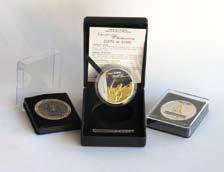
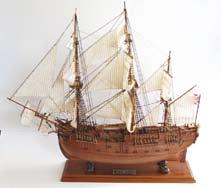
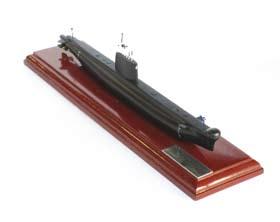

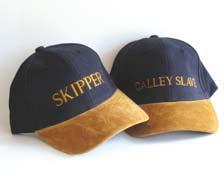

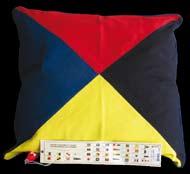
at anmm.gov.au
shop online
Gallipoli medallions and real Gallipoli beach sand Left to right $30, $60, $35 Members $27, $54, $31.50 HMAS Onslow mounted model to patrol your desk Approx 30 cm long $370 Members $333 HMAS Vampire model $25 each Members $22.50 HMAS Vampire mug $15 Members $13.50
fridge magnet set – cruising heritage collection Six magnets $41.70 Members $37.55 Pocket Compass $60 Members $54 Trade winds compass $85 Members $76.50 The Digger limited edition $99.95 Members $89.96 Instant boat in bottle $26 Members $23.40 Why knot learn the ropes? $22.95 Members $20.66 First the replica, now the model HMB Endeavour $450 Members $405 Mini sextant in handsome case height 12 cm $190 Members $171 Ships chronometer keeps you on time, in style $199.95 Members $179.96 Nautical cap to identify your role on board $22 Members $19.80 Signal flag cushion Z for Zulu calls for a tug $79.95 Members $71.95
P&O
Australian National Maritime Museum
Open daily except Christmas Day
9.30 am to 5 pm (6 pm in January)
Darling Harbour Sydney NSW Australia
Phone 02 9298 3777
Facsimile 02 9298 3780
ANMM council
Chairman Mr Peter Dexter am
Director Ms Mary-Louise Williams
Councillors
Rear Admiral Stephen Gilmore am csc ran
Mr Peter Harvie
Ms Robyn Holt
Dr Julia Horne
Ms Ann Sherry ao
Mr Shane Simpson
Mr Neville Stevens ao
Signals
ISSN 1033-4688
editor Jeffrey Mellefont 02 9298 3647
Assistant editor Penny Crino
Staff photographer Andrew Frolows
Design and production Austen Kaupe
Printed in Australia by Pegasus Print Group
Advertising enquiries
Jeffrey Mellefont 02 9298 3647
Deadline end of January, April, July, October for issues March, June, September, December
Signals back issues
Back issues $4
10 back issues $30
extra copies of current issue $4.95
Call Matt Lee at The Store 02 9298 3698
Material from Signals may be reproduced only with the editor’s permission 02 9298 3647
The Australian National Maritime Museum is a statutory authority of the Australian Government
Visit us or contact us at 2 Murray Street Sydney NSW 2000 Australia
www.anmm.gov.au









 left: Stewart Lee on SS Strathnaver 1955. Reproduced courtesy Sydney Lee
left: Stewart Lee on SS Strathnaver 1955. Reproduced courtesy Sydney Lee




























 above: An official of the British colonial government of Tanganyika (Tanzania) checks the mangrove-pole cargo bound for treeless Kuwait.
right from top: Recaulking the hull planking with oakum made of shredded coconut fibre soaked in oil.
above: An official of the British colonial government of Tanganyika (Tanzania) checks the mangrove-pole cargo bound for treeless Kuwait.
right from top: Recaulking the hull planking with oakum made of shredded coconut fibre soaked in oil.
























 below: Kate Lance, author of Alan Villiers Voyager of the Winds at her lecture and viewing of exhibition Sons of Sindbad in July. Photographer J Mellefont/ANMM
below: Kate Lance, author of Alan Villiers Voyager of the Winds at her lecture and viewing of exhibition Sons of Sindbad in July. Photographer J Mellefont/ANMM




























































































